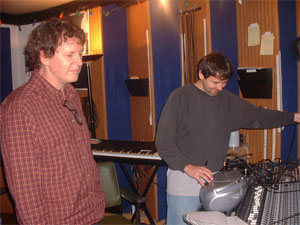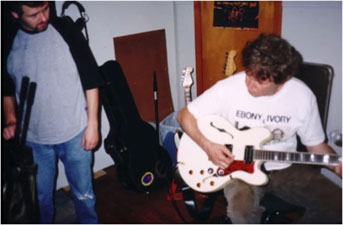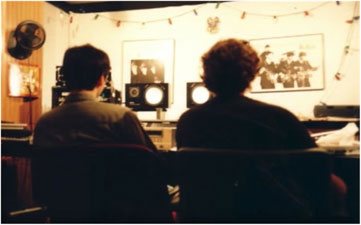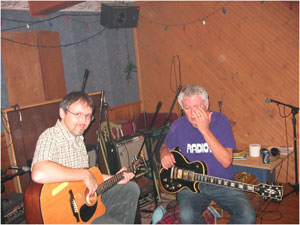| |
|
MAKING RECORDS WITH ROBERT POLLARD (both together and apart)
By Todd Tobias
|
Chapters
|
INTRODUCTION
I'd like to take a look back on the albums I produced for Robert Pollard between 2004 and 2015. A version of this essay was originally shared with visitors to the 2019 Sunday night listening parties organized by Jeremy St James. For those whose interest goes deeper than an enjoyable listen, I hope I can add something to the picture. I have no insight into Bob's songwriting or artwork. And since I worked alone most of the time, I have no funny anecdotes to share about studio high jinx or magical moments of artistic brilliance. These are personal impressions and a few technical notes about my work on the albums, and nothing more.
While listening again to these songs, I sometimes receive flashbacks of random, peripheral happenings to the recording process. There was the day during my work on Coast To Coast Carpet Of Love, when my wife Carla came to pick me up at the studio because my car was at the mechanic's. I told her to please take a seat because I needed about 20 more minutes to nail down a guitar track. After sitting quietly and listening to me play the same guitar passage over and over and over, Carla looked at me bewildered and asked, "What are you doing?" She had a vague idea of what I did but she'd never seen me in the studio doing it. To her it looked a bit mad. Looking at myself through her eyes made me think "Yes, this is a bit mad, isn't it?
"Right now I'm the guitar player," I told Carla. "A couple of weeks ago I was the drummer. Next week I'll be the bass player. But I'm not the singer. He'll be coming next month."
Some would say this is not the proper way to make rock and roll. Without a band playing together, how is it possible for each player to feed off the energy of every other player? It's a good question. To a listener who is unable to peek behind the curtain, does it matter how a song is put together?
I don't know. I guess it's up to the listener. If people dig it, then maybe it doesn't matter. To Bob it didn't matter - at least some of the time. For a while I suffered while second guessing myself over the basic question of whether or not I could pull off being a "band." Eventually I quit asking the question because Bob seemed happy with my work. That was all that mattered. With Bob happy I could put my mind at rest. As to what his fans thought of my work, I didn't have a clue. I doubt if they gave it much thought.
In 2001 at the age of 34 I began working as a sound engineer/producer/performer with Bob and my brother Tim on the rough and ragged debut album by Circus Devils. From there Bob asked me to co-produce GBV's Universal Truths And Cycles, Earthquake Glue and Half Smiles OF The Decomposed - a huge leap for me at that time.
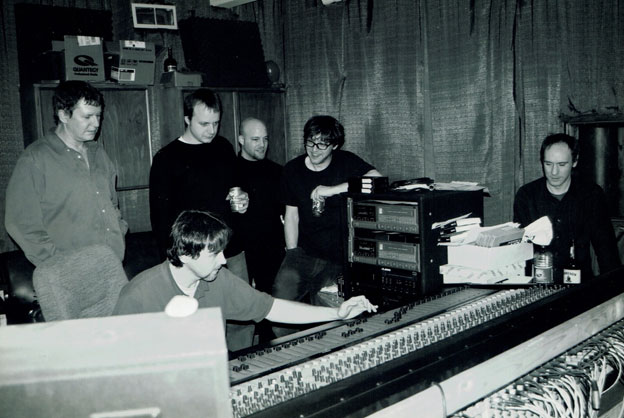
At the mixing desk with GBV, listening to a playback at Cro-Magnon Studio in Dayton during the Earthquake Glue session.
The band from left to right: Bob, Nate, Kevin, Tim and Doug. Todd is seated at the mixing desk. (photo by Matt Davis)
After working with the band and finishing a couple more Circus Devils albums with Bob and my brother Tim, Bob asked me to take over the music recording on his 2004 solo album Fiction Man. This felt like another big leap. As before I was glad for the new challenge and grateful to Bob for his faith in my abilities. I assumed that based on some of my Circus Devils work, Bob had the idea that I could handle all the band duties for his new album on my own. After I passed the audition on Fiction Man, we went on to make 16 more of Bob's solo albums and 3 EPs.
Besides being the best songwriter I'll ever have the privilege to work with, Bob is also the funniest person I've known. I always enjoyed his visits when he made the trip up from Dayton to record his vocals or lay down guitar tracks. He was always full of enthusiasm for the project of the moment, and his enthusiasm was contagious. I'm not much of a talker so I enjoyed listening to him tell stories, or talk about what he'd been up to, or deliver reports from the world of GBV.
The musical bond Bob and I share defies explanation so I won't try to explain it. Something clicked - a kind of unconscious sympathy - that allowed us to get on with making records together without having to talk much about it. That isn't to say there was no communication in the pre-production stage. I would ask questions and propose ideas and Bob would give instruction based on his vision for a song.
Much of the time it was understood what a song needed, but Bob made sure to remind me to "make it kick ass" or "add strings to make it pretty." A couple of times Bob referenced the work of other artists (The Who and John Lennon are two that I recall). But for the most part it was a matter of living with Bob's demos for a few days and letting the songs sink in before knuckling down and getting on with building the finished music tracks.
Bob's demo workhorse was his portable mono cassette machine. On each demo recording Bob accompanied himself on acoustic guitar.

Bob with his long-time songwriting partner
(photo by Rich Turiel)
Often Bob brought the silver boombox with him to a vocal session, which allowed him to reference vocal lines directly from the cassette demo. If a demo recording seemed complete, then it went straight to the album as is. 'Losing Usage,' 'Come Here Beautiful,' and 'Wild Girl,' are a few examples. Bob's demos can also be heard on the Psycho and the Birds records - serving as the basic building blocks on every song.
My job was to come up with the accompaniment to Bob's main guitar - a process involving a number of stages. For the albums From A Compound Eye and Normal Happiness, things were made simpler by the fact that Bob and I performed the initial basic tracks together (Bob on guitar and me on drums). But for the other thirteen or so Robert Pollard solo albums and Eps I worked on, we did not perform together as a tracking unit. I would begin, either with Bob's cassette demo, or with his main guitar track as my primary reference. Using a 4-track cassette recorder, I began by making my own demos, adding in secondary guitar parts and bass guitar. Next, I'd sit down at the drum kit and work through drum patterns while monitoring my 4-track demos through headphones.
Gradually each song would lodge itself in my mind, becoming ingrained enough to allow me to "be" each member of Bob's back-up band. This is important to mention, because I couldn't be the drummer or play anything else until the song came alive inside my head. It was not just a matter of memorizing patterns. Each song was like a painting inside a gallery. In some cases a song could be a little world unto itself. I did my best to find myself inside that world, and not simply be a technician providing serviceable backup.
Once some measure of familiarity was established with a song, I could slip in and out of it without trouble. I could build it up from scratch if necessary. Most important was the ability to add drums without thinking. When it comes to drumming, thinking is the enemy. As soon as the songs were incorporated into my nervous system, I was ready to begin recording - adding one instrument at a time while being my own sound engineer.
Once the song's basic building blocks were in place, I could add in the extras (keyboards, homemade samples and percussion). The next stage was creating a stereo instrumental mix, which I would send off to Bob. This was the part I think Bob enjoyed best - getting the music mixes and hearing for the first time how the finished songs would sound behind his vocals. It was then time for Bob to come up to the studio and lay down his final vocals. Gradually, step by step, I witnessed each song come alive, and shared in Bob's excitement at the vocal recording sessions. Saying it was magical will seem cliché, but that's how it felt much of the time. Next came the vocal mixing, and finally, the songs were sent off for mastering.
Each year there would be a Robert Pollard solo album, or sometimes two. In between I'd be working on Circus Devils music. Thrown in to the mix were three records from Psycho and the Birds. For about 15 years it was like that - no time for rest or to reflect on or celebrate what was happening - just being in the thick of the music. Sometimes it felt like being at sea with Captain Pollard on a years-long voyage to parts unknown.
If I had a problem with being the producer on Bob's solo albums, it was never on account of the oblique character of the material. I usually get along with anything that's uncanny or strange. The problem was coming to grips with the basic idea that I could take charge of Bob's songs and give shape to them. The responsibility of it seemed outrageous, at least at the beginning.
Was I right to be fearful? Looking back, I regret that I had this fear - a fear that I might fail to do right by the songs, or even to ruin them. The fear made me hold back and doubt myself. Sometimes it made me act conservatively when I should have said "to hell with it" and pushed things into a different space. There was always the temptation to make things more my own. You can hear this on Fiction Man. From the very first song, 'Run Son Run,' I seem to be taking charge of the music in a presumptuous way. When I look back I feel that I had to do it that way in order to establish a line in the sand - not with Bob but with myself. If I stepped too far I had to see exactly where that step landed. I had to calibrate myself to stay on the safe side of that line. After Fiction Man I remained on the safe side for the most part, at least where Bob's solo albums were concerned. With Circus Devils and Psycho and the Birds there was little holding back. I tend to think it was a good thing to be cautious with Bob's albums, but on the other hand, there were times when my fear of making things too "weird" kept me inside the box when I might have been more adventurous. Charges of "lackluster production" are probably deserved.
Thankfully the quality of Bob's songwriting transcends the musical treatment of his songs. Because of that fact I don't worry that something I did, or failed to do, might have ruined a song. But at the beginning when I first started working on Bob's albums, I did worry about it. I should have known that no matter what form the musical accompaniment might take, Bob would always manage to shine through loud and clear.
I always appreciated the fact that a close examination of Bob's work will not allow you to pin it down. But there is enjoyment in not pinning it down. I believe the organic elusiveness of the songs is one reason Bob's work will endure. I feel lucky to have been a part of that adventure and I thank Bob for bringing me aboard and awarding me with his trust.
You will find some studio-related minutia here that will likely be of little interest to those who don't mess around with audio gear and instruments. Hopefully there's enough other stuff mixed in for the rest of you to enjoy. I'd like to thank everyone who attended the 2019 online listening parties for all the appreciation they expressed for me and my work. Revisiting these albums with you all has been gratifying and humbling.
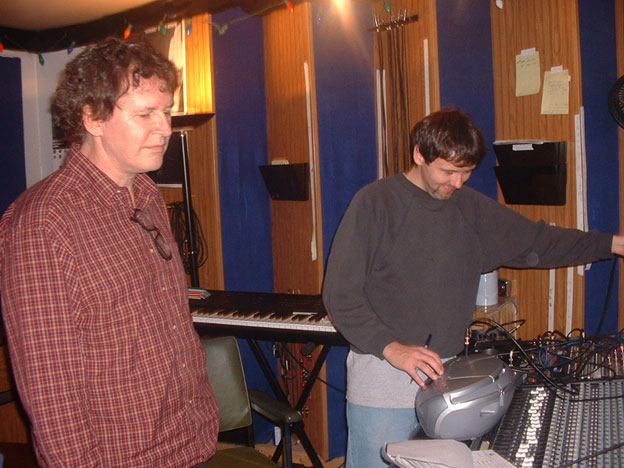
Bob and Todd in the control room at Waterloo Sound in Kent, Ohio during the Half Smiles of the Decomposed session (2004).
(photo by Rich Turiel)
Back to top
|
FICTION MAN (2004)
I would eventually get used to taking on a project like Fiction Man, where I took Bob's acoustic guitar demos and used them as a blueprint to build finished instrumental tracks. But Fiction Man marked the first time Bob asked me to do it.
There is a primitive and playful quality to Fiction Man that wasn't to be repeated in just the same way, especially when it came to the production. This is an album where the "muchness" in the treatments is sometimes too much. This is interesting to me because at that time I was recording on only 8 tracks. In light of the work on all the subsequent albums, where 24 tracks were used, having a limitation like 8 tracks helped to make me more resourceful.
Bob's demos for Fiction Man were leftovers from Guided By Voices' Earthquake Glue, but the songs did not sound to me like table scraps. These were songs I could sink my teeth into. The playful exuberance in Bob's songwriting helped me to put my nervousness aside and simply enjoy myself. Once the songs sank in, I was able to lose myself in the work and forget that I was ever skittish about taking over the musical accompaniment. At that moment in time, if Bob had given me the demos for From A Compound Eye, let's say, then I might have freaked out on my first time at bat. But the small-scale vignettes of Fiction Man were just the right size and scope for me to handle at that time.
I brought my Fostex 8-track reel tape machine to Waterloo Sound; the home studio owned by Scott Bennett in Kent, Ohio where I'd already done work with Bob and GBV. Scott was kind enough to allow me to do my tracking for Fiction Man there. After the completion of this album I'd be recording non-stop at Waterloo Sound until 2009, when I moved the studio to my basement.
When I mention song treatments being "too much," it's mostly on account of the noisy elements - those weird homemade samples of the sort used on the Circus Devils records. I think the song on which the controlled chaos is most effective is the one I already mentioned - the opening track 'Run Son Run.' This was also the very first song I tackled. The result gave me confidence as I moved on to the other tracks.
One tool that helped me deal with the 8-track limitation was an old Webcor tube-driven, single-track tape machine. When I overloaded the microphone signal on the Webcor's input, the result was the kind of nasty and sweet sound you sometimes hear on 1960's-era garage band recordings. This is due to the old-time machinery and vacuum tubes hidden in the guts of the mono tape machine, causing a very specific type of tape compression.
If I set up a single microphone about 5 feet directly in front of the drum kit at chest level, I got a pretty good sound using the Webcor machine.
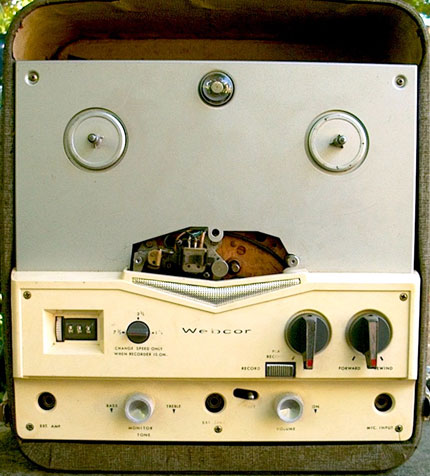
The old mono (single-track) Webcor tape recorder. With no VU meter to monitor the input levels, I always ended up overdriving the signal (causing a pleasant tube distortion). Some examples of the "Webcor Sound" include the drums on 'Run Son Run,' 'Louis Armstrong Of Rock and Roll,' 'Their Biggest Win.' 'Paradise Style,' and later on, 'The Killers' (both versions). Another Webcor track is 'Cock of The Rainbow' from the 'From A Compound Eye' album (vocal and guitar both picked up on a single microphone)
The problem with recording a stand-alone drum track on a mono machine was having no foundational music tracks to play along with. In other words, when I sat down at the drum set, I had no guitar or vocal or anything else to listen to and play along with. It's an example of the importance of having the finished song firmly lodged in my brain before I sit down to play.
With the single Webcor drum track bounced over to the 8-track machine, I had 7 available tracks to fill, minus one or two tracks set aside for the vocals. Sometimes I had to use up an additional track for a kick drum overdub - this whenever the kick drum on the Webcor track got buried once the guitars were added in. On the more aggressive songs it meant only 6 tracks left for instruments and vocals (including the all-important guitars). So every track had to count. It also meant there would be little room for subtlety.
The insistent, manic quality of 'I Expect A Kill,' comes from reproducing Bob's original single-string guitar part from the demo using a parallel combination of electric guitar, high-attack keyboard notes and vocal samples of chanting natives all synched together rhythmically. Part of the percussion backing was achieved by smacking two big stones together and distorting the sound. I know this sounds very cute, but what mattered was the sonic result, which I enjoyed. In those days I was still new to recording, so experimenting in this way was always charged with excitement.
On 'Losing Usage' we hear Bob's original double-tracked demo which captures a composition and performance going on simultaneously as Bob weaves together the vocals and guitar. This was not the sort of song that could be replicated or improved in any way by recording it again, so the original was used.
Chris Sheehan appears as a guest musician for the first time on a Pollard album, adding an elegant touch of piano on 'Conspiracy Of Owls.'
It was fun to change up the approach and give each song its own flavor. On 'Built To Improve' it sounds as if Bob is backed up by a band of ogres. On the spazzy 'Trial Of Affliction And Light Sleeping' it's more like a band of crazed monkeys.
As with 'Trial of Affliction,' Bob's lyrics on 'It's Only Natural' also contain a theme of angst connected to his humor-tempered dismay over the changes going on in our world. That was 17 years ago as I write this. Now I almost feel nostalgic for that dismay seeing as willful ignorance has become institutionalized. As Bob observes; "I can take a garden and turn it into a grave. It's only natural."
My personal favorites on Fiction Man are the pretty songs ('Children Come On,' 'Sea Of Dead,' 'Conspiracy Of Owls,' 'Every Word In The World' and 'Night Of The Golden Underground'). I was glad for the chance to change up my approach and show Bob that I could do more than Circus Devils-style freak rock. It may have been a leap of faith on Bob's part to hand over those pretty songs to me. 'Every Word In The World' is one of those songs of Bob's that gets to me thanks to his poignant melody. 'Night Of The Golden Underground' is another low-key beauty.
Fiction Man marked my discovery of the farfisa organ. As Simon Workman has observed, the farfisa became my go-to keyboard on future albums. I also used the Mellotron flute a lot and other flutey sounds in the arrangements. Bob always requested "strings," which I could sometimes pull off using my Ensoniq ASR-10 sampling keyboard. When I couldn't pull it off, we had Chris George; our go-to cellist on call to provide bona fide strings.
Coming back to the 8-track tape machine used to record Fiction Man, I'd been using it for other albums including Pinball Mars and Five. Looking back, I especially like the work I did on that machine. In later years I'd sometimes get nostalgic for the primitive set up I had with the ¼-inch tape reels, portable ART preamps and radio shack microphones. Later on, when I was able to collect some better gear, some of the charm was lost. Having 24 digital tracks was liberating, but having my hands in the mechanical-workings of the tape machine, for example, made me feel more involved and more a part of the songs somehow. Analog recording in general always feels more real to me, probably because it is. Playing a guitar track and then stopping the tape to rewind and play it back again had a psychological effect of some kind that helped me to feel that I was somehow inside the music. Something of that feeling was lost when I began using the 24-track hard drive digital recorder. I wasn't done with tape recording, however. Scott Bennett had a two-inch tape machine with 24 tracks that survived for two of Bob's upcoming solo projects. I also returned to the 8-track now and then, mostly for Circus Devils.
I mixed Fiction Man at home on my 8-channel mixer and monitored the mixing through a little boom box, just as I'd done while mixing Ringworm Interiors, Pinball Mars and Five. I like to mix on boombox speakers because they tend to reveal how different musical elements sit with each other. Once the bass guitar was added as the final step, I would then switch to headphones and my car stereo to see how things were shaping up on the low end of the EQ spectrum. On the miniature speakers, Bob's vocal sat well in the mix, but during the mastering session I realized Bob's vocal was not punching through the music on certain songs. So that's one regret I have with Fiction Man - not making Bob's voice a bit louder.
Back to top
|
Bubble (2005)
The 6-track EP Bubble was meant to feature songs used on the soundtrack for Steven Soderbergh's minimalist film of the same title set in Ohio. Apart from Bob's acoustic songs, we also recorded a couple of "full band" songs with vocals including 'All Men Are Freezing' and '747 Ego' - a song that was originally planned to be included in a bar scene in the film. In the end Mr. Soderbergh chose to use only Bob's acoustic pieces in the soundtrack. In any case, it was a thrill to take some small part in a project like this.
Back to top
|
From A Compound Eye (2006)
Unlike all the other albums I made with Bob, From A Compound Eye was the only one we made together side by side in the studio from beginning to end. We did this one in the summer of 2005. I may be wrong about this, but I believe it took us 11 days to track and mix all 26 songs.
It was customary for Bob to have a lot of visitors in the studio during the Guided By Voices sessions. But this time Bob had the bare minimum of friends and family dropping in. Among those who sat in for a day were Bob's brother Jim on guitar and Chris Sheehan on piano, both performing on the song 'Gold.' Chris Sheehan also added piano to 'US Mustard Company.' Bob's wife Sarah, who was staying with Bob at a nearby hotel in Kent (home of Kent State University), also dropped by now and then, sometimes to feed us. The result of having few people around was a tension-free recording session in a relaxed environment.
While working on Fiction Man, there were sometimes risky decisions and things got musically exotic, but Bob seemed to dig that. By the time we got to F.A.C.E., Bob was very much into adding in those exotic elements. For better or worse, on this album my trepidation was gone when it came to the musical accompaniment. Today I look back and think some of those extra noises should have been dropped. In Circus Devils it was standard procedure for me to get happy with all the sounds. On Bob's later solo albums I would become much more reserved.
We recorded the album at Waterloo Sound on the ground floor of Scott Bennett's house situated in a fairly quiet residential neighborhood about one mile from the University. The house's unassuming appearance offered no clue as to what went on inside. Scott was usually around and ready to take over as engineer in the control room if I was busy drumming or performing overdubs. He also stepped in as a performer on three songs: 'Gold' (harmonica), 'I'm a Widow' (guitar solo) and Conqueror Of The Moon' (whistling). Scott's whistling was especially appreciated because Bob and I were both no good at it.

2005 - Waterloo Sound, Kent Ohio (aka: Scott Bennet's house)
(photo by Sjors de Vries)
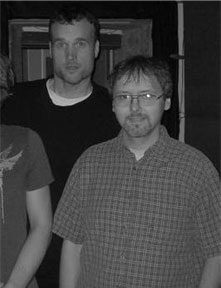
With Scott Bennett at Waterloo Sound (Scott is the tall guy on the left)
(photo by Chris Sheehen)
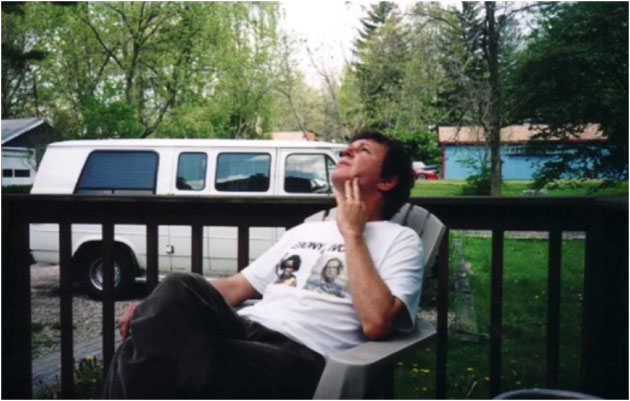
Bob taking a break on the back deck at Waterloo Sound during the FACE sessions
(photo by Scott Bennett)
Whenever we took a break from recording, the house seemed eerily quiet - a sharp contrast to the constant laughter and raucous banter from band members, friends and onlookers during the recording of GBV's Half Smiles Of The Decomposed, which we recorded there a year or two before. While tracking overdubs for F.A.C.E. there was no need to send a messenger into the hang-out room to tell the gang to keep the noise down because the hang-out room was empty. Bob knew I wasn't one for hanging out and drinking, so the picture we presented to anyone who peeked in did not resemble the customary party scene with rooms packed with men (only men) along with piles of empty beer bottles. Getting down to work and keeping our focus sharp was fine by Bob, who I believe appreciated the change of atmosphere, at least for this particular project.
I use the word work, but with Bob present from the first drum count-off to the final fader dip on the final mix, it didn't feel much like work to me. We seemed to fall into a zone where making a record was second nature. We never slacked off, but at the same time there was an almost effortless flow to the recording process that I hadn't experienced before and haven't since. Things just came together painlessly, without a hitch.
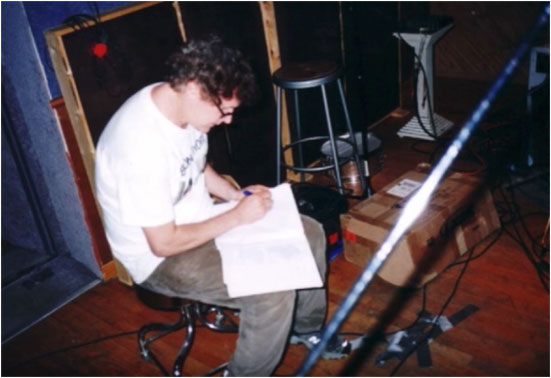
Bob revising his lyrics
(photo by Scott Bennett)
Bob's songwriting was expansive, playful and free, with wide swings from power pop to pretty and gentle to deep, dark and shadowy. Bob's doctrine of "the four Ps" was on display here (pop, punk, prog and psychedelic). Taking my cue from the songs and Bob's tireless energy, I didn't really have the chance to hold back and be cautious. Caution would come later, after I began to work alone again on Bob's later albums. With Bob in the studio I was able to get an instant thumbs up for any and all ideas that came up, including ideas I would not have entertained had I been working alone. To give an example, take the song 'The Right Thing.'
We had a toy whirling drum that I decided to use as a rhythm keeper for 'The Right Thing.' The fact that I had an idea of this kind was the result of the free and open "anything goes" atmosphere. I recorded a few bars with the toy drum and made a loop with it, dropping the pitch of the drum in the process to make it sound less like a toy. Bob and I then played guitar and drums overtop of the loop. In the end, the toy drum became the rhythmic driver of the song. Then came the decision about what to put on the ending of the song. Should it be a guitar solo? A bit of keyboard noodling? "Wait, how about a Jew's harp solo?" Once again, Bob gave the thumbs up. A Jew's harp solo was something I would never again venture, and for good reason. Decisions like this were made with a clear head, without the aid of smokes or special baked goods.
Whenever I second-guessed what I was doing, Bob was there to give the green light. In general we practiced the "Fuck yea, let's try it" school of music production, which can be dangerous. I think what made it safe for us was the fact that we were working squarely in the service of the songs alone. Had we been working in the service of some abstract idea about how the record should sound by struggling to emulate the sound of other records we admired, or else followed the lead of ego by fancying ourselves pioneering recording artists in the throes of great art, then I would have gotten hopelessly lost and the recording would have stretched on for weeks.
I had no trademark production style to put on display, and no bounds to observe as a performer. As a one-man band I was Bob's hired hand. I was not playing for myself. The songs and the show were Bob's. I wasn't there to play Phil Spector and pretend to matter, at least insofar as Bob's fans were concerned. The challenge (or struggle), was to find out what each song was asking for. That's why an album like F.A.C.E. has such a wide range of treatments going on. Every song asks for different things, so the idea is to tune into that silent request. If we made a mistake on F.A.C.E., it was to give a song more than what it asked for. Some songs asked for very little and needed very little, but as I keep saying, I sometimes got carried away with accompaniment and added too much. Whether there were 24 tracks available, or only 8 tracks (as in the case of Fiction Man), it made little difference when it came to my appetite for stuffing the songs with more textures and flavors.
Working by myself on future albums, I often gave in to the temptation to err on the side of caution when it came to the music for fear of ruining a song by being musically cute or clever. This kind of cautious, mindfully careful work can make for a solid record, but not always an interesting record or a record with character. On From A Compound Eye, the musical conservatism I'm sometimes guilty of (apart from Circus Devils and Psycho and The Birds), was put aside. Considering it was a double album, I'm surprised we didn't get caught on any snags of the kind I always encounter while working alone.
On most every album there seems to be at least one song that fails to cooperate. Sometimes two or three. What that "problem song" needed to make it come together always remained elusive. In the end it was always something simple that I stumbled upon. Strangely, on F.A.C.E. there was no problem song and no straining or hammering away to get something right. We just dove in and put it together without a fuss. These days I have a more critical ear than I did back then. But for every time I wince at some unfortunate production decision I hear on F.A.C.E. there are three other moments that bring a smile.
Memory snapshots that come to mind from the FACE session include Bob sitting on the deck at the back of the house going over his song lyrics. As seen in the photo below I clearly remember Bob performing 'Cock Of The Ranbow,' - playing guitar and singing along with the birds and car noise in the background, all captured on tape.
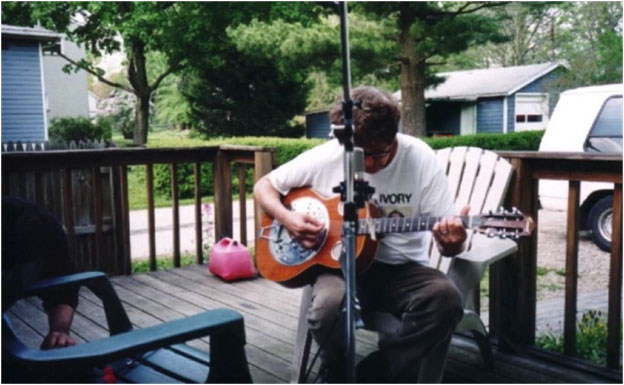
Bob performing 'Cock Of The Rainbow'
(photo by Scott Bennett)
The Dobro you see Bob playing in the photo belonged to Scott Bennet's girlfriend at the time. While Bob sang the song, I messed with my Webcor portable tape machine - the ancient 1950's-made, temperamental, single-track (mono), tube-driven machine used for drums on Fiction Man. You can see the Webcor on the back cover of F.A.C.E. near the bottom. It was first used on Universal Truths and Cycles (2002), on the songs 'Father Sgt. Christmas Card' (on the outro) and on the intro to 'Skin Parade' ("For Christ Sakes Charlie ..."). On this album I also used it to record 'Cock Of The Rainbow' and 'Kensington Cradle.'
A moment not caught on camera (as far as I know) shows Bob's wife Sarah emerging onto the deck during a break to bring us a great meal she'd prepared upstairs in Scott's kitchen. Mostly I just remember seeing Bob in a sustained state of relaxation, sharp focus and contentment. His conversation hinted at a new stage in his musical life. It was time for him to just be Robert Pollard for a while.
I could tell that Bob believed the record was coming together nicely. He was high on the material and pleased with the execution of the songs as we moved along, including all the extra tinkering with keyboards and percussion.
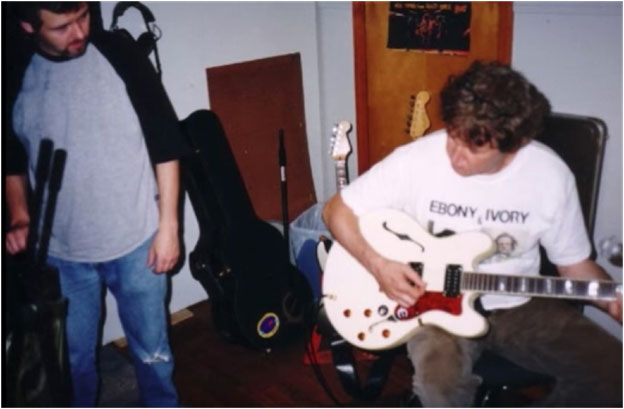
Getting ready to record the basic tracks
(photo by Scott Bennett)
We began the session by laying down basic tracks for each song - Bob on guitar and me on drums. Bob also sang a scratch vocal to help with timing changes. On most of the later albums I made with Bob, the first thing we did in the studio was to lay down the main rhythm guitar track without drums (with Bob on guitar). On a few of the albums where I did the main guitar myself, I would replicate the part as heard on Bob's demo recordings. Once the guitar was laid down, I'd move on to the drums, extra guitars, keys and so on.
On F.A.C.E., with Bob and I playing guitar and drums together, each song found its shape and energy right off the bat. This is something difficult to achieve when playing and recording alone, either on drums or guitar. We needed that exchange of energy between us to make the tracks come to life. On many songs we did only a single take before moving on to the next song. There were a few tricky drum timings that I flubbed on the first few takes. One song I recall practicing again and again was 'I Surround You Naked;' specifically the instrumental intro section with the staggered guitar chords. When I first heard the rhythm of those guitar chords as Bob played them on his demo, it wasn't obvious to me how I should approach the drums. This time it actually paid off to sit down and think about rock and roll - something I'd never done before. I also recall needing some extra think-time to nail down the changes in 'Conqueror Of The Moon.'
Once the solid foundations of guitar/drums were laid down, the next step was adding to the color palette on the friendly and pretty songs (ie: US Mustard Company), and adding shadows and shade to the darker songs (ie: 'Other Dogs Remain'). On a song like 'Love Is Stronger Than Witchcraft,' you have both light and shade in play, with light winning out in the end. The rockers needed no further dressing up apart from an extra guitar. Then there were the "romps": '50-Year Old Baby,' 'Field Jacket Blues' and 'Denied,' where Bob gave me the green light to indulge in the same sort of noisy fun found on a Circus Devils album.
Bob plays the main rhythm guitar you hear on every song. He used a variety of guitars including my Les Paul and Scott's Epiphone hollow body (as seen in the photo above). Bob brought in a guitar or two as well, including a Gibson SG if I recall.

(photo by Scott Bennett)
Performing in the same room with Bob made me a better drummer. I doubt I could have fallen into the pocket on songs like 'I'm a Widow' and 'Hammer In Your Eyes' without Bob there to interact with musically.
I lack confidence as a drummer even though it was my first instrument as a kid. While making records I often wished I had Kevin March or Jim McPherson on hand to take over on drums. Then there was the fact that I never got around to buying a quality drum set. I can't say that my drumming (or my drums) ever ruined a track outright, but that's less than high praise for any musician.
On 'The Numbered Head' Bob wanted to go off into a musical side journey - a prospect that made me nervous as a drummer. I don't do jamming. Maybe it's because I'm not a good enough musician to jam, or because I can't trust myself once I go off script. But more than that, I just don't find jamming interesting as a listener. It makes me impatient and ansty. My solution on 'The Numbered Head' was to employ what I called the "Shoe in the clothes dryer" drum technique, and keep up with the oddly syncopated fills, taking inspiration directly from Ringo.
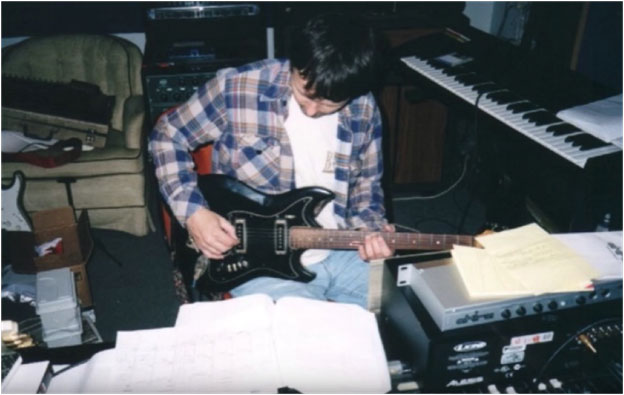
(photo by Scott Bennett)
As a guitar player, my role was to be the Harrison to Bob's Lennon and add non-intrusive, nuanced plucking parts or counter-melodies that were intended to enrich the harmonic picture (See 'Payment For The Babies' or the ending of 'US Mustard Company'). On 'Blessed In An Open Head' and on the ending of 'Recovering,' Bob added his own guitar accompaniment, hitting the spot in a way that I wasn't able to.
In these photos you see me behind my small-scale,1960s-era Starlight Japanese drum kit supplemented with a Ludwig snare. Also in service are my black Hagstrom guitar, also from the 60s, and my mid-70s Fender Precision bass.
The keyboard is the one thing I might have toned down in hindsight. On 'Blessed In An Open Head,' I was able to avoid the danger of keyboard overload by removing the keyboard part entirely and having Bob sing the part wordlessly instead (it's the repeated melodic phrase running through the verses).
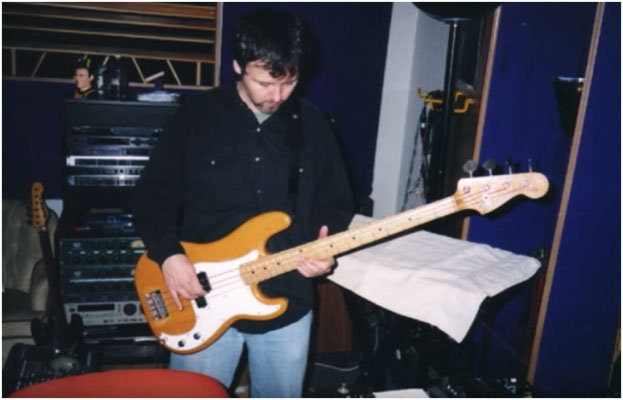
(photo by Scott Bennett)
Bass guitar is the instrument I'm most confident with, and brings me the most pleasure as the element that glues things together and makes things complete. For that reason, I saved putting on bass for last in order to have the satisfaction of finally hearing the songs come together and shake the air the way they're supposed to.
The one song where we veered off script for an hour or so was 'Kensington Cradle' - the runt of the litter. This was an experiment done for a laugh on the Webcor tape machine. I suspect that most listeners to the F.A.C.E. album will skip over this song when it comes up. I feel free to say this because I share a writing credit.

Messing with the Webcor mono tape deck
(photo by Scott Bennett)
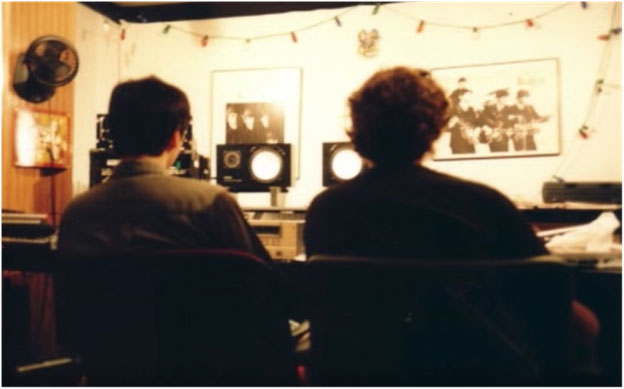
Careful listening at the mixing desk
(photo by Scott Bennett)
Following the obligatory listen to all the finished mixes turned up loud in Bob's car (parked at the back of the house), there wasn't much to say except, "We did good, huh?" Once the whole album was assembled, I was struck by the wide scope of moods, from wistful to defiant to friendly to introspective to playful to dramatic. Bob had good reason to feel proud. The sound of the album is gauzy and warm, due to it being 100% analog. The sound may lack clarity but the warm texture seems to fit nicely with this batch of songs. My personal favorites on F.A.C.E. are probably considered supporting tracks to the more popular songs. They include 'Light Show,' 'Payment For The Babies,' 'Blessed In An Open Head, 'Fresh Threats, Salad Shooters and Zip Guns,' 'Hammer In Your Eyes' 'Kick Me And Cancel,' and 'Other Dogs Remain.'
Over the years I had an intense but fleeting relationship with many of Bob's songs. I'm grateful that he was pleased by my contribution and honored that he put his trust in me. Once in a while someone will remind me of a particular album - usually Coast To Coast Carpet Of Love - and say something kind, reminding me that it's ok for me to feel proud of the work as well.
Bob's future solo projects seemed to take off from the foundation laid down by F.A.C.E. They include the introspective, sometimes dramatic and serious moods on Silverfish Trivia, The Crawling Distance and Moses On A Snail. Then there's the friendly, self-assured, outgoing atmosphere of Coast To Coast Carpet Of Love and We All Got Out Of The Army. Then there are the playfully eccentric moods on Standard Gargoyle Decisions, Elephant Jokes and Space City Kicks. There's also the joyful delirium of We've Moved by Psycho and The Birds. All of these moods can be found on From A Compound Eye; an album that brings many good memories.
Back to top
|
Normal Happiness (2006)
The demos for Normal Happiness (originally titled Gasoline Ragtime) did not sound to me like a continuation of From A Compound Eye. Bob's songwriting on F.A.C.E was big and expansive, so I tried to give that album a big sound. The songs this time were more inwardly focused and intimate, so I decided to try for a tighter sound in a smaller space by putting the drum set in a storage closet. With some blankets draped on the walls for sound dampening, it helped to give the drums a tighter, punchier sound.
This was the final all-analog Robert Pollard solo album that I produced. It was recorded on the Sony MCI 2-inch tape machine at Waterloo Sound - the same machine we used for most of Half Smiles Of The Decomposed and F.A.C.E. That tape machine gave the album its warm and wooly sound.
The Normal Happiness session was also the last time Bob and I played all the basic tracks together (drums and rhythm guitar). It's always important to undergird each song with the right energy. Playing together with Bob made that much easier. On hyper-kinetic songs like 'Accidental Texas Who,' and 'Full Sun (Dig The Slowness)' having Bob there playing along on guitar had a liberating effect for me and made the drumming fun and easy. By the way, Bob did not have to squeeze into the closet with me and the drum set. We kept an eye on each other through an open doorway while we played.
The task I set for myself on this album was to apply guitar layering for harmonic richness and/or to enhance a song's emotional affect. A fortunate example of this is the fluid plucked guitar part in Boxing About.
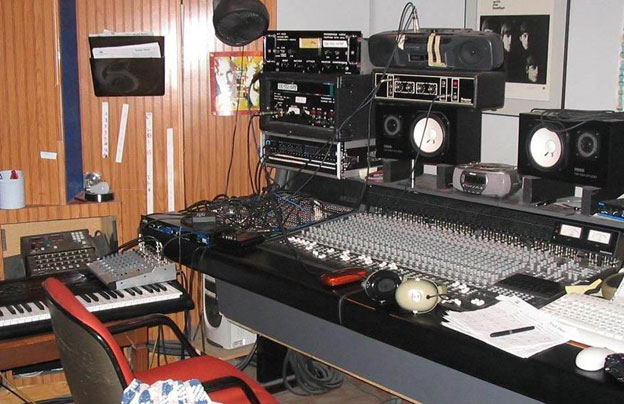
The Waterloo Sound control room in 2006
(photo by Todd Tobias)
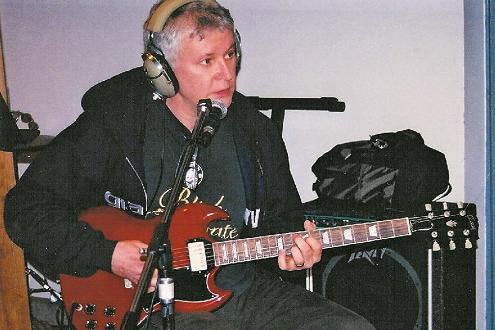
Bob tracking with an SG
(photo by Scott Bennett)
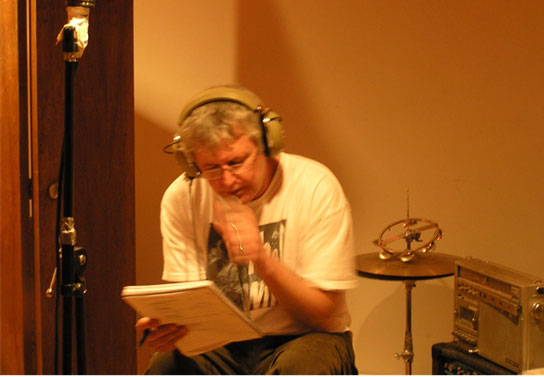
Bob doing a vocal take with a hand-held mic - in this case a Shure SM48.
(photo by Scott Bennett)
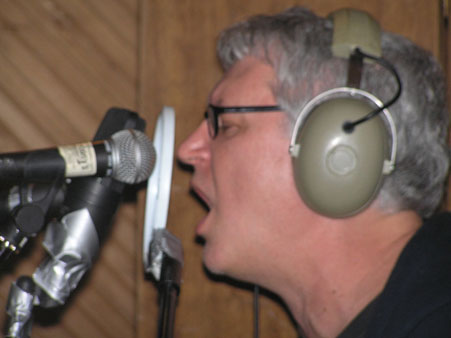
At the mic stand with the Audio Technica condenser mic and pop-screen.
The SM48 you see here was used as a talk-back mic.
(photo by Scott Bennett)
Between about 2003 and 2009 we had a wonderful piece of equipment at Waterloo Sound - a monstrous handmade, tube compressor unit built by a guy I will call Keith, who allowed Scott Bennett to park the compressor at the studio in exchange for studio time. A few of the albums which benefited from the compressor were Half Smiles of the Decomposed, F.A.C.E., Normal Happiness, Sgt. Disco, Ataxia, Coast To Coast Carpet of Love, Standard Gargoyle Decisions, Silverfish Trivia and Gringo. Keith was an electronics wizard and gifted sound engineer. Sadly, he also had an addiction to heroin. To support his habit, he rented out his handmade compressor units to big name producers, including the guy who produced Mariah Carey.
For those among you who are not sound engineers, a compressor squeezes the dynamics of a sound (makes the soft parts louder and the loud parts softer). When applied to vocals, it helps to normalize the volume of the voice - and when applied to instruments, it gives the sound a certain punch and presence. On Normal Happiness, the guitars and vocal benefited a lot from Keith's compressor.
For a long while Keith seemed to have disappeared, and he'd left behind this amazing compressor at the studio. Naturally I continued to use it. At some point a few years later Keith got in touch and asked me to return his gear - a sad day for me. When I delivered the compressor to his house, Keith yelled at me from behind his closed door.
"Who the fuck are you?!"
"It's Todd," I answered.
"Todd who?" he snapped. "I've got a gun!"
I should have run away and kept the compressor, but instead I gently reminded Keith why I was there.
"What the fuck do you want?" he yelled, interrupting me. "I've got a gun!" he repeated.
Finally, Keith opened the door. Instead of a gun he was holding a huge, heaping bowl of Count Chocula, or maybe it was Cocoa Krispies. Anyway, it was one of those brown, sugary cereals I used to eat when I was a kid. The bowl was not cereal-sized, but one of those big mixing bowls used for cake batter. Keith looked terrible, with gray skin and deeply sunk-in eyes. When he spotted his big compressor sitting on the porch he finally settled down. I decided not to accept his invitation when he asked me to step inside. After that odd encounter I keenly felt the compressor's absence at the studio and wondered whatever became of it. Maybe it showed up on recordings by Coldplay or Justin Bieber. It was a great help on plenty of our projects. So I offer a belated "thank you" to Keith, wherever he may be.
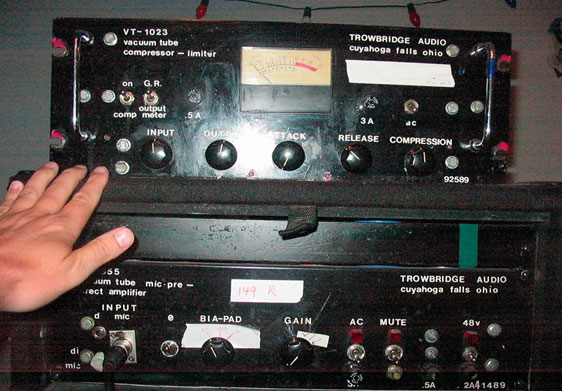
Keith's magical hand-made tube gear
(photo by Todd Tobias)
One thing I remember about Keith was his conventional musical tastes. Once when he stopped in at the studio, I was busy mixing something from the Standard Gargoyle Decisions album. He stopped to listen, cocked his head, then looked at me and shook his head, as if to say "What the fuck is that shit?" There was a look of pity on his face.
I don't imagine Normal Happiness is an album that clicks with listeners right away on account of the mix-up of moods and styles and the impression that the party is private - this in contrast to F.A.C.E., on which Bob seems to be singing directly to everyone. This is just my own impression.
There are exuberant, high energy songs ('Accidental Texas Who,' 'Supernatural Car Lover,' 'Full Sun (Dig The Slowness)'), pretty, wistful songs ('Boxing About,' 'I Feel Gone Again'), loony songs ('Gasoline Ragtime,' 'Whispering Whip'), pop songs ('Rhoda Rhoda,' 'Get a Faceful') and dark songs ('Give Up The Grape,' 'Pegasus Glue Factory') and then there is 'Serious Bird Woman.'
I'd like to know where 'Serious Bird Woman' comes from. I didn't ask. At first, I thought the tortured longing in Bob's vocal was an ironic put on, but then I began to suspect that it wasn't. The decision to take it as 100% honest and heartfelt made my musical approach simpler. Playing it straight, I used shifting guitar chords meant to accentuate the sad longing in Bob's voice. I still find something oddly uncomfortable about 'Serious Bird Woman.' For some reason I had Bob stand across the room from the microphone when he sang this one. That's what accounts for the odd vocal sound. I think this approach to the vocals was also taken on 'Towers and Landslides.'
Once again, Chris Sheehan makes an appearance, adding an exciting synthesizer at the tail end of 'Full Sun (Dig the Slowness)', and putting a nice touch on the closing of the album.
Back to top
|
Coast To Coast Carpet Of Love (2007)
I don't know if it's common knowledge, but the songs on the albums Coast to Coast Carpet of Love and Standard Gargoyle Decisions were all written for the same heaping double album set to be called Coast to Coast Carpet Of Blood.
I remember Bob handing over the demo collection for the ambitious double album set to be the follow up to 'Normal Happiness.' This was an exciting group of songs, but as a complete album, I noticed a schizophrenic mood. In one camp were the friendly songs and in the other camp, the more challenging, playfully eccentric and darker songs. The line between the two groups was easily drawn, without much overlap. As I began what would become a two-month long recording session (my longest ever), I kept thinking: "This should be two separate albums." While I appreciated Bob's artistic ambition, my thoughts were with the listeners. How could you go from 'Miles Under The Skin' to 'Butcher Man' without feeling jarred?
Many years later, in 2021, Bob decided to create a single album (Our Gaze) by hand-picking songs from both collections originally released as two albums ('Coast to Coast Carpet of Love,' and 'Standard Gargoyle Decisions'). So in the end, the issue was not in having a mixture of different moods, but rather in the sheer volume of tracks. By cutting it down to a single LP, the interplay of moods worked much better.
I believe as a double album, From A Compound Eye had been a big, bold statement for Bob, casting a bright light that would be difficult to outshine. Whatever had made that group of songs flow from one to the other in an effortless way was absent on the newly planned double album. I could tell as much by listening to the demos in random order. However, when Bob picked out the friendly songs and put them all together into a single album collection, suddenly the thing lit up and came to life as Coast To Coast Carpet Of Love.
The remaining half of the former double album then became Standard Gargoyle Decisions. As with its lighter twin, a distinct personality and identity emerged when these songs were bunched together. A favorite of mine in this collection is the spaced out 'The Island Lobby.'
Even before the double album idea was dropped, I decided to segregate the songs and record them in two separate groups. My dividing line pretty much reflected Bob's when it came time to split the double album in two, with just a couple of exceptions ('Folded Claws' and 'Penumbra'). 'Penumbra' was recorded along with what would become the Standard Gargoyle set. And 'Folded Claws' was bunched in with the set of friendly songs. When I think of 'Folded Claws' as part of Standard Gargoyle Decisions and 'Penumbra' appearing on Coast To Coast Carpet Of Love, I think of the Yin Yang symbol, where you see the two opposing halves - one dark and one light, but within each half is a small piece of its opposite. Maybe this was Bob's way of reminding us that these two albums were once a single creature before being broken in two.
I'd like to remind everyone of the astonishing act of faith on Bob's part in putting his songs into my hands. He wasn't even popping in to check up on my progress. It's hard to imagine the levels of anticipation he suffered through while I was working. He told me a few times that receiving the finished work was like being a kid on Christmas morning. There are people who might think it's impossible to ruin a good Bob Pollard song. I can see why someone would think so, but I can tell you that when I took a wrong turn with a song, ruining it was a real possibility. I like to think that I was always able to catch myself and make the correction. Nobody has heard those aborted versions because they were destroyed. I could use the word 'deleted' here instead of destroyed, but no. They were destroyed.
The work began with me studying Bob's demos and learning Bob's guitar parts. Once I put the main guitar parts down, they served as the foundation for each song. In other words, I carried on by playing the drums, following along with the guitar tracks. In effect, I was pretending to be a band, doing my best to play off the energy of that other "me" who played whatever other instruments I was not playing at the time. Once the drums were down, layering on new instruments became less troublesome thanks to the timekeeping.
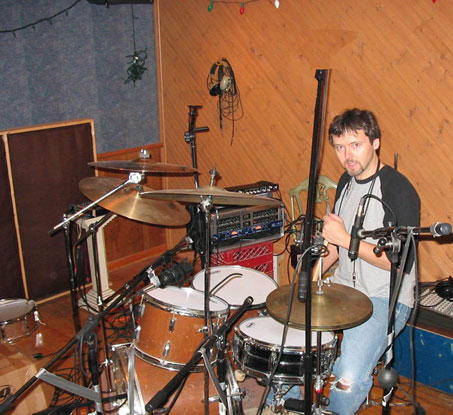
Drumming on Coast to Coast Carpet of Love / Standard Gargoyle Decisions
(photo by Scott Bennett)
Sometimes I had to call Bob and ask how he played a particular passage on the guitar demo. I may have found the right notes on the guitar neck, but sometimes I was playing it on the wrong string, which gave it a different sonic character. I learned that Bob likes to focus on the lower (deeper pitched) strings of the guitar. He also has a unique, aggressive way of attacking the strings with a guitar pick. Sometimes I tried to emulate that forceful way of playing. It helped me while figuring out the guitar parts to know that Bob does not use alternate tunings. By contrast, when writing material for Circus Devils I rarely used standard tuning. Bob's "correct" tuning helped to make things simpler. But even though Bob did not mess with the tuning, sometimes the pitch on his strings had drifted off the mark. I would then re-tune my guitar to match Bob's. In other words, an F chord on Bob's demo might be closer to an E chord on the piano, but only because the tuning had drifted on Bob's low E string, which he then used to tune the rest of his strings. I suspect this would only be of interest to fellow musicians, and maybe not even then.
A good deal of time was spent figuring out secondary guitar parts, added in to broaden the harmonic picture, while at the same time being careful not to hijack the song and take it to a foreign place. As always, the bass guitar - the glue that binds it all together - was added in last.
My assignment - or the assignment I gave to myself - was to realize the music without calling attention to myself as a performer. This had not been my approach on Fiction Man, where I let myself off the leash.
My role on Coast To Coast Carpet Of Love was to be a tailor, and not a fairy godmother. A good tailor is invisible. You can admire a nicely fitting suit without having to think about the work that went into making it. I wasn't there to pretty up the songs in the way a producer of mainstream pop would do, by putting a sonic stamp on the record. The songs were great - always a good starting point. In my view a naturalistic treatment was all they needed, with the sounds of real (non-electronic) strings and membranes vibrating the air. There was no need to gussy things up, and besides, I didn't have the skill or the tools or the know-how to make a mainstream-sounding pop record. Staying clear of keyboards was one thing I decided early on. 'When We Were Slaves' was an exception. But I still had to dress up each song using the customary tools (guitars and drums). I wanted the listeners to hear a song and not think about things like the drums and bass or the "band" that played them. The thing was to preserve an illusion that the songs were something organic that grew up out of the fertile ground of Bob's imagination already fully formed - as if they had jumped straight from Bob's head onto the record. Anyway, that was the assignment.
The one song in this set that proved difficult - and there is almost always at least one - was 'Slow Hamilton.' This song required three or four versions before I got it right. I kept thinking, "Part C needs to be prettier." This is the part with the lyric; "A life beyond slow Hamilton's scheduled day." That particular section needed heightening and broadening, but at first the missing element would not show itself. Attempts at prettying it up with keyboards sounded painfully forced and out of place. At last I fell into a silky guitar part that glued things together nicely and helped the song lift off the ground where it needed to go.
Work on the set of weirder songs comprising Standard Gargoyle Decisions would be more comfortable for me. Not easier, just less fraught with danger, which may seem counterintuitive. With these meaner songs, instead of being a tailor, I was more like Dr. Frankenstein - assembling the bones and organs and hoping that a living creature would be the result - and not just a heap of dead body parts.
Realizing a friendly (more conventional) song meant approximating what was in my head in terms of instrumentation and treatments. Things had to be glued down tight with the proper drumbeats and all the notes on the supporting instruments had to be just right - as in "there is no other note that works but the right one."
However, with the weirder songs in this set, I had nothing fixed in my mind before I began. Instead of getting things "right" I was just feeling my way through as I went, with the hope of discovering the finished song instead of seeking to establish something already mapped out in my head. This made recording the darker and weirder songs more enjoyable. I think that's why I saved them for last.
When everything was done, I felt the treatments on the Coast To Coast album were too simple, maybe even boring and predictable - especially in light of the more adventurous work on Standard Gargoyle Decisions. Bob reassured me that I'd done well. But it's taken years for me to get past my doubts. Now I can listen back to it and feel pleased with everything going on in Coast To Coast Carpet Of Love. In the end, I believe a gentle touch was the right touch.
The lonely marathon recording session at Waterloo Sound that produced these two albums went one step farther in terms of my energy investment than anything I'd done before. I felt challenged and privileged to be building these albums, working from Bob's set of blueprints. But then I was also happy to go home and leave the construction behind. There was a time when I wasn't able to simply listen and enjoy these songs the way others do. It was like having an intense relationship that leaves you exhausted. You just want some distance. But now that several years have gone by, the songs confront me now like old friends.
Back to top
|
Standard Gargoyle Decisions (2007)
This is an album where Bob's "anything goes" approach to songwriting is on display. Some of the songs have the quality of being born in a dream ('Pill Gone Girl,' 'Hero Blows the Revolution,' and 'Butcher Man' come to mind). Songs like these seem more like spontaneous eruptions than compositions.
I feel I could have done even more to accentuate the weird/ mean/ funny/ scary qualities in these songs, especially on the songs with a tossed-off quality. It was a case of holding back out of uncertainty in the mixing stage because I was working alone. If Bob had been in the studio with me, he might have given the green light to any number of eccentric touches that I decided to cut. In the back of my mind, there is always a voice warning me, saying "Don't get too cute."
This was the sort of album that invited messing around. There is never any harm in adding extraneous stuff in the tracking stage. But when it came time to mix, I wanted to make sure the songs shone through without the cute distractions. It was a Robert Pollard record, not a Circus Devils record, so I exercised caution. An analogy to this would be shooting a film with inclusion as a guiding principle, and then editing with extreme prejudice.
The demo for 'The Killers' was first recorded by Psycho and The Birds. For this new version I decided to use the same ancient Webcor mono tape deck used on the drum kit for that original version. The intro to 'The Killers' with the whiney voice snippet: "Bob, we gotta - we need to do it this way," coupled with the "Webcor Sound" of the sweetly distorted hi-hat, announced the album as something very distinct from Coast to Coast right from the start.
I remember Rich Turiel being at the vocal tracking session. He and Bob can be heard shouting "Here Comes Garcia!"
'Come Here Beautiful' is simply Bob's demo with some keyboard additions in the style of Psycho and the Birds. It's one of my favorites on the album, along with 'Pill Gone Girl,' 'Motion Sickness Ghosts' and 'The Island Lobby' - a song in which I felt especially at home as a musician.
Back to top
|
Silverfish Trivia (2007)
I remember Silverfish Trivia starting off as a full-length album. But the result did not sit well with Bob. He didn't go into his reasons for breaking up the album, but I guessed either he was unhappy with some of the songs, or else unhappy with my production - or some aspect of my treatment of the songs.
I associate Silverfish Trivia with The Crawling Distance, but on that later album the solemn, downbeat songs were offset by a few playful rockers and a couple of pretty tracks. That sort of wide-swinging dynamic was missing on the original, full-length Silverfish Trivia. Instead of keeping listeners off balance, it kept an even keel throughout. Maybe this was the problem. Anyway, Bob's solution was to keep the best three songs, add in a few quietly unassuming but emotionally affecting tracks to solidify the mood, and make it an EP. The result is a record with a big, low-key personality - if that makes sense? Anyway, it's not the sort of personality Bob is generally known and appreciated for. This might be why Silverfish Trivia and The Crawling Distance remain my two personal favorites among the solo albums I recorded with Bob.
The songs that were cut from the original album became a collection of B-sides, including 'Coast To Coast Carpet Of Love' (the song), 'Piss Along You Bird,' 'Met Her At A Seance,' and 'Street Velocity.' With these songs gone, what remained defines a unique atmosphere, better focused and uncluttered.
The trio of songs: 'Circle Saw Boys Club,' 'Touched to Be Sure' and 'Cats Love a Parade' were too good to share an album with those other tracks, and needed a showcase of their own ... or so I assume Bob's thinking went. With supporting tracks like 'Wickerman Smile' and the cello instrumentals added in, the record contains for me a special warmth and emotional gravity. As Bob's work goes, the atmosphere here is uncharacteristically "heavy." By that I don't mean a heavy rock sound. I mean the sort of heaviness that comes when you create in the service of emotion and the soul. Of course, what passes for "emotional" and "soulful" in popular music is insipid hash next to the richness you hear in songs like 'Circle Saw Boys Club' and 'Touched To Be Sure.' Anyway, I always appreciate the results when Bob goes to these deeper places.
The work by our go-to cellist Chris George on 'Come Outside' was based on Bob's demo - with Chris playing both Bob's guitar part and vocal melody note for note on the cello. In the case of 'Speak of Many Colors,' everything the cellos do here was taken from a recording of two guitars - one Bob's and one mine - with my guitar doing interweaving harmonies on top of Bob's main guitar (taken from the demo). Once again Chris matches everything Bob and I played on the two guitars note for note. Since I don't read or write music, Chris was left on his own to write his charts by listening to the guitar tracks and transcribing every note. It was astonishing to hear the result after I'd gotten used to the all-guitar version. It seemed to put the song into another musical dimension.
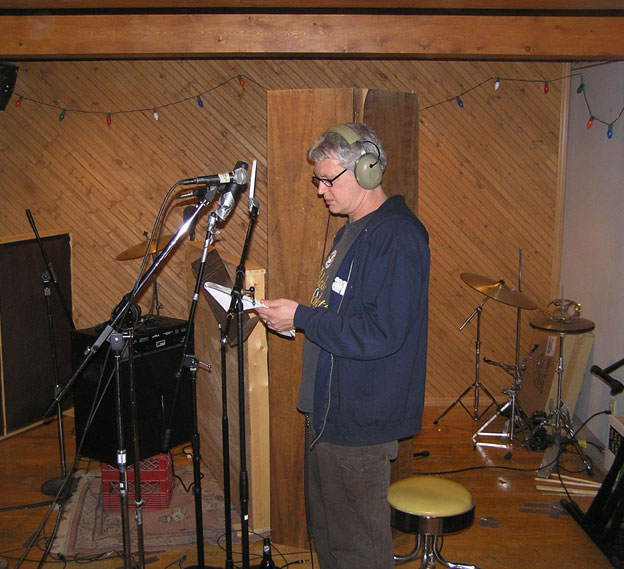
Bob at the vocal mic
(photo by Scott Bennett)
The prog odyssey 'Cats Love a Parade' took some planning, first from Bob in its conception, and later on with the recording. After hearing the demo, I knew we would not be recording the entire song in one go. It was the first time we'd recorded a song with movements and recurring themes, and also the last time. The song is like a trip that sets off and ends up in the same place, with the main adventure going on somewhere in between. Bob laid down his main guitars and vocals in 5 separate chunks. From there I had fun piecing it all together. At the very beginning of the track we hear a snippet of audio taken from Bob's DVD player. As Bob explained it, while watching a movie he pushed the forward skip button on his remote, and the audio stayed on. The result is the sound of clipped voices captured on Bob's cassette recorder. He didn't say what the movie or song was, but the snippet sounds to me like 'The Battle Hymn Of The Republic.' The intro, ending and weird middle sections were recorded on my 8-track Fostex ¼-inch tape machine - the same machine used for the recording of Fiction Man and the quiet songs on Universal Truths And Cycles and From A Compound Eye.
For me the intro/ending sections of 'Cats Love a Parade' have the quality of speaking directly to the listener, drawing you closer as if Bob is whispering a secret. Some listeners might recognize bits of the music in the big splashy sections because they first appeared on the Psycho and The Birds EP Check Your Zoo, with Bob using Psycho and the Birds as the farm team. The middle section contains some added color from me in the tradition of Circus Devils. It may not sound like it, but I practiced restraint here.
Taken as a whole, Cats Love A Parade can either be a dizzying, delightful trip or else leave you stranded. I get that some people are turned off by this sort of expansive songwriting, and prefer their songs to be served up in easy to swallow nuggets. But those people can at least admire Bob's ambition here. For me this song is a deep dive into some internal dimension where Bob felt at home, at least during that period of his life when the song was written.
Back to top
|
We've Moved by Psycho And The Birds (2008)
Not a Robert Pollard solo album, but still me working with Bob's songs. The difference here is that Bob's original demos were left in on every song- serving as the foundation for each song over which "the Birds" added their instruments.
In the midst of a very active two-year period of recording (2006-2008), Bob and I completed a mess of albums including From A Compound Eye, Normal Happiness, Coast To Coast Carpet of Love, Standard Gargoyle Decisions, Sgt. Disco, Ataxia, and two full length albums and an EP from Psycho and the Birds (Bob on acoustic guitar and vocal / me on the other stuff).
I understand how Psycho and the Birds might be regarded as a hiccup or tiny footnote in Bob's career, but I'll try my best to make the case for bothering to listen to (and get acquainted with) the band's third and final album We've Moved (2008). It's an album that may require a period of adjustment before the enjoyment arrives.
The first Psycho and the Birds album was a lark, assembled by me taking a collection of Bob's demos and adding in accompaniment directly on top of those rough recordings. This would be our M.O. for the other two P&B albums as well. For the listener it meant some difficulty making out Bob's lyrics above the controlled racket taking place, created by the drums, bass, keyboards and electric guitars, all joyfully added with no thought of reigning in whatever musical impulse took hold. Bob seemed unconcerned with the unavoidable burying of his vocals and me getting happy with all the musical extras. This project was about raw feelings. The lyrics were of secondary importance, which may be another reason Psycho and the Birds has been overlooked (apart from the songs being judged sub-par). I think the songs are great, and recording 'We've' Moved' was the most fun I've ever had as a musician.
Bob's demo process sometimes comes in two stages. First comes the initial run with Bob seated with guitar in front of his recorder (in those days the famous cassette boom box pictured in the chapter on F.A.C.E. and on the cover of Circus Devils' Five), with the melody taking shape inside a mixture of legible phrases and nonsense syllables. From there, stage 2 picks up with Bob taking that first version and honing the melody and writing proper lyrics to carry it. Many of the Psycho and the Birds songs were built upon the foundation of Bob's stage-1 demos before the lyrics were fleshed out. Instead of lamenting this fact, think of it instead as eavesdropping on Bob while he's in the throes of giving birth to a new song and travelling on a self-propelled wave of instant discovery. And he's not alone on the wave. Riding along with Psycho are The Birds, doing their best to keep up.
These are songs that can be enjoyed as pure expressions of the id. As such it's fun to hold on to the illusion that the songs sprang up fully formed with no musicians taking part. Musically, everything you hear on We've Moved is very coherent and locked into place. But at the same time the songs seem to follow some offstage logic or dream logic that's difficult to pin down.
For me as a listener, this tension between what seems composed and what seems improvised all happening at the same time is the source of the album's charm. And along with Bob's vocals, it's a source of the album's humor. Once the songs sink in, the album becomes a joyful experience. Listening to it now, it seems to have the vibe of a backyard party where a strange band performs on the backyard deck - the sort of band where the members are huddled together and hunched over their instruments, having great fun while remaining totally oblivious to the crowd. The band also has a shitty PA system that makes it very hard to understand the singer. But there is an infectious exuberance to the songs that overrides any fear of weirdness, allowing the party to carry on and even to escalate.
Bob would probably describe We've Moved as "ridiculous" - this being a term of endearment for him. On a few of these songs, the unhinged musical accompaniment makes it sound more like "Bird and the Psychos." There are moments of pure delirium on We've Moved, especially if you blast the volume and/or enjoy a smoke before putting it on. But hiding behind the weirdness is a friendly soul born of pure fun. Even casual listeners can enjoy songs like 'I Love A Revolution,' and 'Enon Beach'.
Bob said 'She Tears Out' was among his first attempts at writing a song. I can imagine the 12-year-old Bob cracking himself up while writing the lines "She tears out in her new Jaguar - outta sight - out of this life."
The pretty instrumental 'Poor Old Pine' is the one island of tranquility here, unless you also count 'Tomorrow Man;' a snapshot of deep disconnection or perhaps bemused alienation starring a man (or ghost?) who appears to be watching strangers from his window as they walk down the street. "Walking with socks, shoes ... and feet," he reports, speaking of all the people who pass by - suggesting that he himself does not possess these things. The noises you hear which serve as the sonic setting of 'Tomorrow Man' include a doorstop (the springy kind) being continuously plucked - the way a bored child might pluck it. There is also a tape loop made from a piece of old vinyl - just as the needle is dropped before the first song begins. When I first heard the demo of 'Tomorrow Man,' I asked myself "What is this?" What should I do here? Add in some beatnik jazz? In spite of the cryptic weirdness, the track somehow manages to avoid being scary, and comes off as a breezy interlude before the party atmosphere returns the instant 'Corona Grande' kicks in.
'Corona Grande' sounds to me like a mash-up between early 1970s American Bandstand and a late 1950s Sam Phillips production. Bob's semi-wordless chanting in this song is hilarious to me and kind of astonishing.
There is a moment in the song 'I'm Never Gonna Leave, You're Never Gonna Win,' when Bob is propelled forward by a different sort of wordless chanting - this time more primitive and desperate. I hadn't heard something like that from Bob before and it surprised me when I first put on the demo. I don't even know how to use the alphabet to approximate the sounds he made.
There are echoes from party bands of the early 1960s. Then there are shifts to the early 1980s and a punk vibe. Mixed in-between are song styles that might have been but never were. For example, remember the "mouth trumpet" craze from 1971?... Probably not because it never happened (see track 10: 'Hound Has The Advantage'). Taken as a whole, the album is like a dream taking shape in rock and roll's collective unconscious (ie: Bob's unconscious).
Back to top
|
Robert Pollard Is Off To Business (2008)
Looking back, I'm surprised at how each of the albums I made with Bob have their own distinct flavor. This includes the four GBV albums and everything we did in Circus Devils and Psycho and the Birds. All together it came to about 38 albums in all. What set Off To Business apart was Bob's tightly focused, carefully composed songwriting. I could tell Bob had put a lot of preparation into the construction of these songs. Some of them had an almost austere quality.
On an album like this where I served as a one-man band, the customary feeling leading up to the recording was butterflies in the stomach brought on by the new challenge. But as I prepared to record Off To Business, I felt scared. While studying Bob's demos, some of the songs began to feel weirdly oppressive and claustrophobic. I wasn't able to explain it because it never happened before, and after this album it never happened again.
The songs that worried me were tracks 1 through 4 (The Original Heart, The Blondes, One Years Old, Gratification To Concrete) and track 10 (Wealth And Hell Being). The more I dove into these 5 songs in the planning stage, the more pushy and exacting they seemed. I latched on to the idea that there was only one way of getting these songs right - which meant there were a thousand ways of getting them wrong. Once that idea took hold, it guaranteed a rough time for me. Working alone also made it easy to fall prey to my own insecurity. I've written before about the weirdness of making records alone. As I've mentioned, to an outside observer, this method of record-making might even seem a little bit mad. Sometimes it's important to have someone else there to tell you, "Things are fine, quit belly aching." Likewise, it's good to have someone around to tell you, "Come on, that was crap."
I decided to delay my discomfort and begin with the songs I knew I'd enjoy working on best. I especially enjoyed playing 'To the Path!' and 'Confessions Of A Teenage Jerk-off'. 'Western Centipede,' 'No One But I' and 'Weatherman and Skin Goddess' were also stress-free and enjoyable. These songs were no less polished and carefully composed by Bob, so I have no idea why the other half of the album caused me so much trouble.
As part of my drive to do things "right," I did something I never did before and phoned Bob during a recording session. This happened during the tracking for 'Gratification to Concrete.' Bob and I would discuss an album beforehand in the planning stage or else establish the guitar chords, but I had never called to bother him during the process of recording and mixing an album, partly because I knew he enjoyed the surprise and excitement of receiving the music fully cooked and ready for the vocals to be added, which always came last. The sticking point on 'Gratification to Concrete' was in the verse section - an empty space in each measure where I wanted to insert a repeating guitar lick.
For about two full days I did nothing but try out different guitar parts until I was ready to smash the guitar. I wasn't used to this kind of trouble, or I might have had the sense to walk away and give myself a breather. When it began to affect my digestion, I finally switched my approach and tried a vocal lick in place of the guitar. I had no plans of using my voice on the finished mix, but I could at least try to use my voice to give shape to something, and then play the same notes I sang on guitar or keyboard later on. After putting the guitar aside, it was a matter of minutes before I came up with something functional - a five-syllable vocal part which I then played on a farfisa organ with distortion and a wah-wah effect. As a hook, it sounded silly and dumb to me, but it fit.
So, I had the missing puzzle piece in place, but every time I listened back to it, I felt pain. It got so bad that I decided to break my own rule and get Bob on the phone. I held the phone up to the studio monitors and had Bob listen to the verse playback. He listened to it, then I put the phone back to my ear. At first there was silence. "Let me hear it again," Bob finally said. "Oh shit," I thought. He heard it again, then he said "Yeah, I think it's okay." It was not a big vote of confidence, but nonetheless came as a huge relief. At that point I didn't care that Bob wasn't thrilled with it. I was just tired of being my own worst enemy and eager to move on.
Now I can look back and say that all of my trouble had its origin in the thought that those five songs had to be "exactly right," whatever that meant. It was a case of exercising head-level thinking over gut-level instinct. If the songs have the quality of being overcooked production-wise, it's because I smothered them with too much attention. What this means from a listener's perspective, I don't have a clue. Probably nothing at all.
A couple things to share about the song "To the Path!" One is taking inspiration from The Who's "Love, Reign O'er Me" with the string layering. And on the ending section, I experimented with different percussion beds to achieve a galloping effect. The percussion I settled on was a "talking drum" loop, which had a subtler effect than simply bashing on the tom toms.
Putting my issues aside, Bob did some amazing singing on this album. What comes to mind are the vocals on 'No One But I,' and the first and middle sections in 'Confessions Of A Teenage Jerk-Off.'
Back to top
|
Weatherman And Skin Goddess (2008)
Weatherman And Skin Goddess contains the song 'Coat Factory Zero' on which I imposed myself to a greater degree than usual. The song begins with ominous rumbling and ends with a lilting sort of plaintive guitar theme. Both of these parts I added in myself, unsure if they would make it onto the finished record. One thing Bob is never keen on is a literal interpretation between song lyrics and musical effects or figures. Using music or sounds to invoke the word 'Factory' in the title was a no-no. I also object to this sort of musical cuteness, but on this song I thought I'd break the rule and come into the song's space from "underground" with the rumble and rhythm of figurative machinery.
Back to top
|
The Crawling Distance (2009)
Somewhere between Silverfish Trivia and The Crawling Distance, Bob seemed to go in and out of songwriting periods where the material was shaded by melancholy and introversion - at least that's what I was hearing. There is a "heaviness" to some of these songs that keep them alive in my imagination - not as catchy things that pop into my head, but more the way memories and dreams rest under the surface.
On songs like "It's Easy,' 'No Island,' 'Red Cross Vegas Night' and 'On Shortwave,' Bob appears to be deep diving into his subjects in a way that leaves us behind and at the same time offers us a warm invitation. There is a hint here of some emotional depth and sophistication that I can't fathom, but at the same time I can feel and intuit what's going on. As always, I was tempted to find out from Bob exactly what he was getting at with his lyrics but I always held back from asking, judging it disrespectful.
Even though I had the responsibility of recording the music for The Crawling Distance, the nature of the songs made me wary of imposing myself as a musician. Bob had asked me to keep the rhythm section sparse and dry on a few of the songs, using John Lennon's Plastic Ono Band album as a reference point. Holding back was the proper way to approach this album, whereas on many of the playfully eccentric albums that came later (We All Got Out of The Army, Elephant Jokes, Space City Kicks and Mouseman Cloud) I was itching to get into the studio to have fun with the songs as soon as I heard the demos. The Crawling Distance I approached with more reserve and reverence.
On the album's downbeat opener 'Faking My Harlequin' I used a combination of acoustic and electronic percussion - something I also did on 'Coat Factory Zero' From the Weatherman and Skin Goddess EP. The rhythm bed on these two songs was mechanical in its timing, so it allowed for that kind of treatment, though I was wary about doing it.
Bob was conscious of the album getting too solemn, so he threw in a couple of rockers to keep things balanced, including 'Cave Zone,' - a song that confused me because it was so simple, especially lyrics-wise, with the message "Please leave me alone!" I like that Bob narrows down his escape options to three places: China, a South Sea island, or Montrose. While recording Bob's vocals I always enjoyed it when he slipped into his Jerry Lewis (Professor Kelp) voice, as he does here in the non-verbal vocal section.
I think the melody on track 3 ('Red Cross Vegas Night') is one of Bob's prettiest. For once the cello here is not played by Chris George. It was originally intended for Chris to play. But then I made a guide track for Chris using a cello sampled from a classical music recording. To my ears the sampled cello sounded just fine, so I kept it in the song, though it lays down low in the mix.
At the time it was recorded, I overlooked 'The Butler Stands for us All.' To me it sounded like Bob slipping into a comfortable suit, and offered no real challenge for me as a performer. But now when I hear it, I enjoy the comfort zone it offers. I understand now how only Bob could do this song. Imagine any other singer attempting it and it doesn't come off.
There was one intrusive touch I made on The Crawling Distance that I'm proud of. On 'It's Easy,' I decided to insert a repeating interlude where "clouds of confusion" roll in and threaten to swamp the song, before being quickly vanquished the instant Bob gently sings the words "It's easy - easy - easy." To my ears the swell of churning notes added a bit of tension that actually served to accentuate the song's calmness and sense of peace.
One of my favorite Bob rockers is 'By Silence Be Destroyed' - another playful moment (after 'Cave Zone'), allowing us to take a break from the album's gravity. I enjoyed playing the driving rhythm punctuated by sudden hiccups and banging the drumstick on the metal rim of the floor tom. I always laugh when I hear Bob erupt in his righteous voice, "Hey! Don't give me the guilty finger."
'Imaginary Queen Anne' was the rare conventional-type song that I had no trouble stepping into. The extra guitar work came voluntarily into my head, which is always nice. That way I didn't have to spend hours searching out the parts on the neck of the guitar. Bob plays the main acoustic guitar here.
"On Short Wave" was the one song on the album that offered me plenty of space for adding atmosphere. The real cellos this time are played by Chris George.
After the quiet devastation of "On Short Wave " - a song no one is likely to raise a beer to and sing along with - Bob decided to close the album with something more energetic, lighthearted and mad. 'Too Much Fun' teeters on the edge of creepy crazy. I'm partly responsible for the Captain Kangaroo vibe here because of the musical arrangement with that tinkling piano during the refrain. When I hear Bob sign off at the end and shout "Do - Come - Again," I get the feeling he is not making a request, but instead issuing a direct order. While recording the song, I had a picture in my mind showing Bob dressed in tights as the pied piper leading all the kids out of town.
I may have had a better time recording other albums, but as a listener, The Crawling Distance, along with Silverfish Trivia, are my favorite Robert Pollard records. I think they especially make great companions on long, lonely car trips.
Back to top
|
Elephant Jokes (2009)
Maybe I'm wrong but I believe many of Bob's fans found Elephant Jokes to be a challenge, at least until familiarity set in. I smile a lot when I hear this album, but it's hard to know what sort of reaction listeners will have. Someone once told me that they "lost patience" with this album. I suspect they were just being polite because they knew I played on it. For me an album like this was enjoyable to work on because it had the feel of a funhouse with many rooms. At the same time, I was careful not to have "too much fun."
Apart from 'Cosmic Yellow Children,' I tried not to allow musical cuteness to take over and compete with Bob's vocals. Another song that contained too many musical intrusions was 'The Annex,' which Bob cut from the album. This was a good decision because the song's clownish weirdness does not match the more indirect and sometimes vaguely disquieting weirdness and comedy in the rest of the songs - maybe with the exception of 'Hippsville (Where the Frisbees Fly Forever)'. For those who have not heard 'The Annex,' you can find it on YouTube.
The rockers on Elephant Jokes are inelegant but also full of wild energy (see 'Epic Heads,' 'Symbols and Heads,' 'Tattered Lily,' and 'When A Man Walks Away'). I especially like Bob's queasy guitar riff on 'When A Man Walks Away.' There is internal tension in these songs that threatens to break them apart from the inside, but they somehow manage to hold together.
Then there are the loony songs ('Newly Selected Dirt Spots,' 'Perverted Eyelash,' 'Pigeon Tripping,' 'Cosmic Yellow Children,' 'All You Need To Know' and 'Architectural Nightmare Man'). I think Bob felt confident handing over songs like this to me because of our work in Circus Devils. I have some phobias as a musician, but weirdness is not one of them.
Mixed in with the loony songs and rockers are a few pretty songs ('Parts Of Your World,' 'I Felt Revolved,' 'Compound X,' and 'Desiring') and some eccentric pop songs played in a lock-step rhythm ('Johnny Optimist,' 'Stiff Me,' 'Accident Hero' and 'Jimmy').
Taken all together I imagine it must be disorienting for first-time listeners. In spite of the scattered styles and moods, somehow the album still has its own unique identity that can't be confused with any of Bob's other albums.
The album's opener 'Things Have Changed Down In Mexico City' is an oddball among oddballs for being more or less a conventional song. Then there is "Spectrum Factory," another oddball for being the only song on an album I produced with Bob where he plays bass guitar. After tracking his bass part, Bob winged the vocal performance at the microphone while looking at lyrics written by his wife Sarah.
An album like this allowed me to test my ability to obey the injunction "Do what the song wants." This had nothing to do with the song lyrics. It was about how to treat the song; choosing drum patterns, figuring out accompaniment, using guitars and keys to emphasize a mood, figuring out how much delay and reverb to apply to each element and so on. One thing that helped was to treat the songs as if they were living things. As creatures they could better communicate their intentions. Whether or not my interpretations work is up to the listener. This is rock and roll after all, so the plan of attack usually wasn't a mystery. But Bob is a songwriter with a sense of adventure, and his more adventurous songs were open to interpretation. The main things I tried to achieve were to give the song the correct level of energy, apply musical dressing to enhance whatever mood or emotion was going on, and build a 3-D space for the song to live in using different reverbs and delays, and finally, to keep musical cuteness in check (when possible). A record like Elephant Jokes, along with Fiction Man, From A Compound Eye, Standard Gargoyle Decisions, We All Got Out Of The Army, Space City Kicks and Mouseman Cloud were all fun challenges because they all contain songs that allowed for adventurous treatments.
I'm aware that talking about music production comes off as abstract. To take a couple of specific examples: in 'Compound X' the song seemed to be asking for Spanish/gypsy flourishes, and a fast Bolero beat on the final section. The castanets were deleted in the mixing stage - an example of keeping cuteness in check. For better or worse, I did not ask Bob to approve my treatments before making them final. I think he enjoyed the surprise.
'Tattered Lily' came to life in my mind as an animal or beast that runs for its life before falling down or being taken down. Again, this is purely a musical image for me, and has nothing to do with the song lyrics. The beast falls down, and Bob's tremolo guitar at the end is like the beast's final breaths before it expires. By treating the song as a living thing, it seemed to "ask" to be allowed a few final growls of defiance before it died - the growls coming in the form of those big, mean guitar chords you hear at the end.
I know the above description can have little meaning for listeners, but it's an example of the sort of thinking that went into a song treatment. I guess treating songs this way is something like treating household objects as living beings with feelings, like when you hear the spoon cry out because it got dropped in with the forks. Knowing that the forks might gang up on the spoon and bully it, you quickly lift the spoon to safety. Okay, maybe nobody else does that - at least not for the same reason I do it.
On this album our brothers make an appearance. Bob brought his brother Jim to the recording session, and I recall Rich Turiel being there too. You can hear the guys celebrating at the end of 'Johnny Optimist.' ("Yeah! yeah! yeah! yeah! yeah!" ... and so on). My brother Tim also makes an appearance, playing one of the guitars on 'Cosmic Yellow Children.' My friend Steve Five stopped by at the studio one day so I had him play the soaring guitar at the end of 'Hippsville.' Bob baked most of the guitar riffs into the songs himself with a few exceptions - one example is the riff at the beginning of 'Epic Heads,' which was based rhythmically on Bob's vocal line in the verse.
If you're new to the album or still getting to know it, by the time you're deep into side 2, you might start to feel some discomfort and get the feeling that Bob is having a laugh at your expense. I can see fans of Bob's friendlier work complaining of self-indulgence. My response to that would be yes, of course it's self-indulgent! On lots of these songs Bob is giving himself a laugh. During the recording there was a lot of laughter going on too. But I can see how an audience might have trouble feeling part of the fun.
In this context, a disarmingly heartfelt song like 'Desiring' might seem less than sincere. But it's only an illusion created by the surrounding funhouse mirrors.
A couple of people have mentioned to me how much they dislike the song 'All You Need To know.' One of them described it as a "violent dislike." No one has ever said this to me about any of Bob's other songs. After hearing about this, I had to go back and find out what made the song so offensive to them. Maybe they judged it to be lazy songwriting. Personally, I tend to think it's a case of the listener getting upset about not being let in on the joke. I guess it either tickles you or it doesn't.
I believe it was during an Elephant Jokes recording date - one night I was tracking bass guitar when I stepped out for a sandwich. When I came back, there was no signal on the bass guitar. I checked everything twice, then again - all the connections were good. Finally, I examined the microphone cable and found it had been severed as if by a razor blade or wire cutters. It was a clean slice, not chewed through by rodents, or crimped in any way. Scott - the studio owner, was gone for the day, and as always, I had locked the door on my way out. But here was this severed microphone cable - cut by some invisible agent inside a 15-minute window of time between me leaving the studio and coming back with my sandwich. Nothing like it had ever happened before, and gladly it never happened again.
Below are a couple of photos taken during the guitar tracking session for Elephant Jokes. I believe these were taken in early 2009.
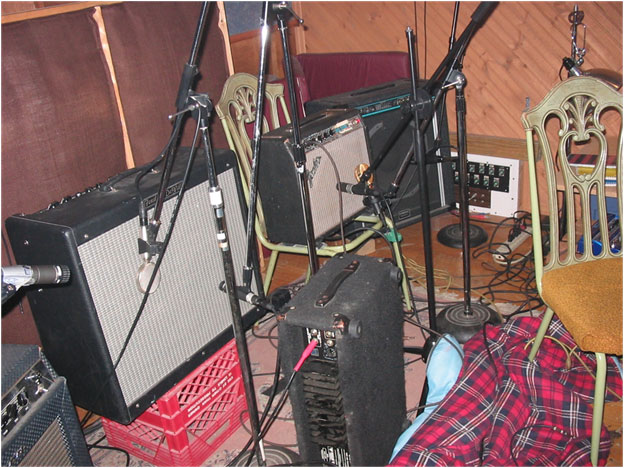
The little amp on the right is a Fender vibro champ. On the left is a Fender Deville. In the bottom left corner you see a bit of the Ampeg amp which Jim Pollard dropped to achieve the "amp drop" noise heard on one of the GBV albums we recorded there at Waterloo Sound a few years before. I believe the amp head sitting on its side on the floor is actually a Traynor spring reverb. I used this reverb a lot on Bob's voice. For the sound engineers among you, each amp has 2 mics on it - a Shure sm57 and a ribbon mic. When combined and corrected for phase, the resulting sound was nice and fat.
(photo by Todd Tobias)

Bob is playing my Gibson black beauty - a guitar that had its head stock broken off three times. So far, the latest glue job has held up. I have Bob's "scud" guitar - the acoustic used on most of Bob's demos and studio recordings from this period.
(photo by Tim Tobias)
Back to top
|
We All Got Out Of The Army (2010)
We All Got Out of The Army was the first project done in my then new basement home studio built in 2009/10. Some of the gear was pulled out of the old Waterloo Sound, which Scott Bennett was kind enough to let me keep. I had done a lot of work at Waterloo so Scott was appreciative, and maybe glad not to be lugging the big mixing desk to his new place in Portland, Maine.
I still have the mixing desk, microphone stands and a few mics and rack units from the old studio. Everything else I collected little by little as I went along. I've also had to sell away pieces of gear over the years during lean times.

The new control room at my home studio (2009)
(photo by Todd Tobias)
At the time of making We All Got Out of The Army, I was excited to have my own place for recording but also anxious about the kind of sounds I might get. At the old Waterloo, the drum room was spacious thanks to the hardwood floor. I was accustomed to that room and the sound of the drums in there. My basement has cramped rooms with linoleum floors and concrete block walls. In other words, it's a terrible environment for recording drums. So, I built a shallow wooden riser for the drums and put them in a room padded down with insulation to prevent the kind of ugly standing waves basements are notorious for. The result was one of the best-sounding records I did with Bob. I made good use of a digital reverb that simulated a room sound, which I was against using in principle, but coupled with the wooden drum riser, it worked out fine.
In terms of Bob's songwriting, this is a crazily playful and adventurous album. Style-wise it's all over the place, but somehow still holds together. Every song is strong in an unassuming way, with a distinct personality and vibe. There are some songs that defy description. One song ('Red Pyramid') even sounds like Crazy Horse. My favorites are 'I Can See,' the prog-nugget 'His Knighthood Photograph.' 'On Top of The Vertigo,' the punkish title track and the final track 'Faster To Babylon,' which Bob lets us know "will not be the title track, though maybe it should." I also like 'Wild Girl' and 'I'll Take the Cure.' I guess I should just list them all as favorites.
The setting of my home is a wooded, suburban area. At the rear of the house the basement floor is flush with the ground outdoors. In my control room there is a big window that looks out onto a wooded scene where deer and other woodland creatures routinely appear. Having Bob come there to record was a big change from the cave-like, window-less environment at the old studio, where you could never tell if it was day or night outdoors. I joked with Bob that I should start doing sessions with folk singers in my new environment. At any rate the surroundings are decidedly not rock and roll. But this had no effect on the music as heard on future albums including Space City Kicks, Mouseman Cloud, Lord Of The Birdcage, Jack Sells The Cow, Honey Locust Honky Tonk, Blazing Gentlemen, every Circus Devils album following Gringo and GBV's Bears For Lunch.
In the basement studio I began using a particular microphone on Bob's voice - an Electro-Voice 635A. For some reason this mic helped Bob's voice cut through the distorted guitars. On songs with acoustic guitar I had Bob sing into an Audio Technica condenser mic. I nicknamed the EV 635A the "Howard Cosell mic," after the 1970s era sportscaster who always used this microphone on TV. Bob would perform with the Howard Cosell mic in his hand stage-wise instead of having to step up to a mic stand with a pop screen. Bob liked to sit with his notebook in his lap and sing while looking down at the lyrics. Having the hand-held mic made that a lot easier.
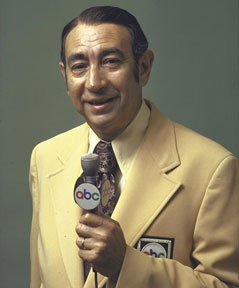

The mighty Electro-Voice 635A as used by Howard Cosell, and by Bob on plenty of songs.
Each time Bob arrived to do a vocal session or a rhythm guitar session, he would finish his work in a single sitting, never requiring an overnight stay at a hotel. The days of the studio party atmosphere were over, at least until the return of Guided By Voices, and a visit to the home studio to record a couple of tracks for Class Clown Spots A UFO, and then the entire Bears For Lunch album. There is a reason I did not include 'Moses On A Snail' in the list of albums made in the basement studio - a reason I will clarify below.
I wasn't sure how I felt about We All Got Out of The Army at the time we made it. I had to get away from it for a few years before it sunk in. I don't know what kept me from digging it right away. Maybe I was nervous about the new studio sounding up to snuff. Bob has since reminded me that he really likes the sound on this record. These days it's one of my favorites.
Back to top
|
Moses On A Snail (2010)
Still unsure about the new basement studio, I decided to move the equipment up the stairs. For Moses On A Snail, I put together a small mobile recording unit and hauled it up to my living room. My wife and kids were off to stay with the in-laws for 3 weeks, so I figured I'd move all the furniture out and move the drums, guitars and amps in. I did it only because the house was empty and I was curious to find out what it might sound like to record in a new and unfamiliar space.
This would be the only time I recorded an album of Bob's outside a studio (including my basement studio). It also meant that my neighbors had a chance to listen in. The nice lady who lives across the street commented, "You sure like to play the same things over and over." I probably should have reassured her that I wasn't really losing my mind, just busy recording my drum and guitar parts and trying my best to play them all the way through from beginning to end without flubbing.
The experience of tracking in the living room was new, but the resulting sound was not drastically different. The hardwood floor did add a nice high-end EQ shine on the drums. And the extended space (relative to the basement) allowed for microphones to be placed down the hallway and in the kitchen. As a result, there was a certain bigness to the sound that could be achieved without the use of extra digital reverbs. Anyway, it seemed to be the ideal space to record a song like 'Arrows and Balloons.'
When recording music from scratch (as opposed to Bob laying down a main guitar first) I sometimes had to call Bob before the recording began to confirm the main guitar part, asking him about the placement of his fingers on the guitar neck. This time he made it simpler by including notes with the demos, only Bob does not read tablature. So what he wrote were notes in long hand detailing which finger was pushing down where on the guitar neck. One song in particular ('Each Is Good in His Own House') was a concern for Bob, so I played it for him on an acoustic guitar over the phone to get his stamp of approval before I carried on putting it down on tape. On drums, 'Each Is Good in His Own House' was also a difficult one to work through. I recall spending almost an entire day going back over the drum track again and again until every accent was nailed down. It wasn't that it was difficult to play - once I established what to play. Sometimes too many possibilities bring complications, so it was a matter of eliminating every single "bad" possibility until only the good ones were left.
Moses On a Snail is a low-key album that doesn't call attention to itself. This is reflected in the album cover. When I first saw it, it reminded of me of something from a cassette rack in a drug store from the 1970s. But I think that was the idea. It wasn't always the case, but I noticed how Bob would put a photo of himself on an album cover instead of using a collage whenever he was expressing himself in a more direct and personal way (See Jack Sells The Cow, Silverfish Trivia, Coast To Coast Carpet Of Love, From A Compound Eye).
Bob told me he wrote 22 songs in one afternoon. After tossing out 10 of the songs, what was left became Moses On A Snail. As with The Crawling Distance there is a core of deeply felt songs. And mixed in between are songs like 'Lie Like A Dog' and 'It's News' - added in to provide balance and relief by changing up the mood so things don't get too "heavy" in the emotional sense. A good example of keeping the mood light is 'Big Time Wrestling' where we get to hear Bob scat in the outro. Personally, I would have enjoyed an entire album of the emotionally heavy-type songs, both as a performer and a listener.
I like that Bob opens the album with a sleepy, melancholy song ('The Weekly Crow'). For him that seemed an uncharacteristic move. But that song was made to come first.
On 'Teardrop Paintballs,' I used a timekeeper borrowed from Circus Devils - originally a slowed-down percussion loop lifted from an old Arthur Lyman LP. it helped to put the song in a different space as opposed to simply tapping on the high hat or else letting the guitars float free in the air with no rhythmic grounding.
The closing title track made me nervous because of the extended instrumental section. Once I had the drums and rhythm guitar down, I went through different versions, soloing on both guitars and keyboards. The results were worse than bad. I began with this idea that I had to somehow channel Jimi Hendrix. After falling on my face time after time I turned things down several notches while trying to preserve a sense of drama. In the end I settled for the performance I judged to be the least objectionable. Working alone without a cheerleader handy always made it easy to doubt myself.
The song here that gets to me is 'Arrows And Balloons.' Bob's vocal performance just hits the spot in every way. I also enjoy 'How I've Been In Trouble;' a sad song with a core of strength mixed with defiance - something Bob can pull off better than anyone.
Back to top
|
Space City Kicks (2011)
Pre-production on a Robert Pollard album was usually conducted quickly over the phone, with Bob laying out his vision for the record - it's general mood and style. For Space City Kicks Bob had more specific instructions for me. I'm able to quote Bob directly because I saved the handwritten notes he sent. Here are a few excerpts:
1. Mr. Fantastic Must Die: "Make this song diabolical. Extend the ending with wild leads."
2. Space City Kicks: "Kick ass and chug."
3. Woman To Fly: "Pretty and impassioned."
4. Touch Me In The Right Place: "Make punchy with a lot of snap in the snare drum. Maybe add in power chords."
5. Blowing Like A Sunspot: "Pretty and lilting, maybe with strings. No fade."
6. Picture A Star: "Haunting and weird. Add intense strings like on 'Other Dogs Remain.' Play toms in rhythm with the chords. Get that 'Dreaming The Temple' sound from Circus Devils Five. Add in distant explosions and sounds."
7. One More Touch: "Pretty and brisk with fairly busy drums."
8. Sex She Said: "Make it kind of fucked up (like it is). Keep the ending fucked up (like it is). Nice directions, huh?"
9. Something Strawberry: "Goofy and pretty. Alternate between being muted and opened up. Keep it short."
10. Follow A Loser: "Driving and pounding with a quirky synth or something. Keep it short, no fade."
11. Tired Life: "Power Chords."
12. Stay Away: "This should blast ass like early Who."
13. Children Ships: "This should be almost psychotic."
14. I Wanna Be Your Man In The Moon: "This is the hit. It should kick ass and still be pretty, especially the chorus."
15. Squeeze The Kids: "Just use this take (original demo). Let me know if you want to add anything."
16. Gone Hoping: "Keep it sparse and breathy."
17. Into It: "Keep it light (Maybe acoustic)"
18. Getting Going: "Driving and pounding. I play it by lifting my fingers up and down on the chords."
19. Spill The Blues: "sparse (maybe only acoustic)"
You'll notice the song sequence above does not match the song sequence on the album. At the time the notes were written, Bob was still adjusting the track order. Also, track #15 ('Squeeze the Kids') was dropped from the lineup. While I took Bob's notes as my starting point, once I began work, sometimes a song dictated where it wanted to go.
For example, on 'Touch Me In The Right Place," Bob envisioned a more all-out rock sound, but to me it worked better as a tightly wound little package with canned drum sounds and a bass synth. For this song I made my own homemade drum samples. It meant that instead of sitting down to play the drum set, I pecked out the drums on the keys of a keyboard. This felt strange but fun. The tambourine is the only "real" percussion element in this song. On a later album I would use the same drum samples on a song called 'Science Magazine,' only run through a distortion filter.
Bob's suggestion to add wild leads at the tail end of 'Mr. Fantastic Must Die' brought to mind the dueling lead guitars at the end of the Beatles 'Abbey Road' where Paul, John and George trade guitar licks. Here, Bob and I trade the licks. Maybe you can tell which is which? I'm not sure this song turned out as diabolical as Bob hoped. It's a bit of a mess.
On 'Picture A Star,' I tried Bob's suggestion of laying on heavy strings or a synth, but to my ears it put too tight a focus on things. I preferred to keep it open and airy on top, and transfer the meandering line I wrote for the strings to the bottom - as a repeating bass line. I remember doing a mix with the big strings doing the bass line, but it had the quality of a children's song or a ditty. To what extent decisions like these were a disappointment to Bob I don't know because he didn't say. One suggestion he made that I was able to include were the "distant explosions." These were actual canon shots bathed in reverb to give them a cosmic feel.
Apart from 'Touch Me in the Right Place,' the most intrusive production going on here is found on 'Children Ships.' I'm not sure if I pulled off "almost psychotic" as Bob instructed, but I like how the vocal melody line and the rhythm interweave in an off-kilter way. The effect here is more queasy than psychotic, but I'm proud of the result.
My usual nerves about playing lead guitar were absent on this album because only one song (apart from 'Mr. Fantastic Must Die') needed a guitar lead. This came at the tail end of 'I Wanna Be Your Man on The Moon.' Luckily the idea for the snaky lead popped into my head note for note so I didn't have to search for it on the guitar.
The two "bar band" songs here are 'Tired Life' and 'Follow A Loser.' On 'Follow A Loser' I decided not to add in the synth as Bob requested. I gave it a try but it seemed weirdly intrusive. 'Tired Life' always brings a smile, probably because it makes me picture Bob in front of a real bar band testifying to a room full of weary working-class stiffs.
'Sex She Said' is another one that makes me laugh. I might have "fucked this one up" as Bob suggested, but to me Bob's vocal delivery and the lyrics themselves achieved the proper effect without pushing things over the edge with crazy musical touches. On this one I began by assembling a rhythm track using canned drum sounds, including a homemade sample of two big stones being smacked together - as heard on a couple of older songs ('Pill Gone Girl' and 'I Expect A Kill'). Then I played real drums overtop when the big, heavy guitar comes in, and Bob sings "Don't make it all sound so heavy."
When it came to the pretty songs ('Woman To Fly,' 'One More Touch,' and 'Blowing Like A Sunspot'), Bob's melodies carried the day. There wasn't much these songs needed apart from giving the voice a lush bed to rest in. At the outset I laid on a lot of mellotron strings and flutes, but in the final mixes, all the flowery stuff I put in was taken away to let the vocal take center stage.
I tend to associate the three albums 'Space City Kicks,' 'We All Got Out of The Army' and 'Mouseman Cloud' with each other, maybe because these albums all have a similar playfulness. They are full of songs that don't resemble each other - each a fully formed individual that seems to have little to do with all the other songs it's packaged with - and yet each collection holds together as a coherent whole. I counted my work a success whenever I was able to contribute to a song's distinct mood or flavor. At the same time, I put myself in check, careful not to load down the songs with needless additions.
Back to top
|
Lord Of The Birdcage (2011)
Maybe I'm wrong, but this is an album I'm guessing might be overlooked because the music and melodies are relatively more understated and unassuming. Bob's lyrics are always self-assured, but on this album, they also seem to be more inward-looking ('Ribbon Of Fat' aside). The production is also low-key, or "lackluster," if you're looking at it critically. To me this album is reassuring and even comforting, partly because of the non-invasive "softness" of the sound, but also because the album has nothing to prove and no one to impress. Each song embodies its own frame of reference, and requires the listener to gain entry on his or her own with no help from musical or vocal hooks. My favorites are 'Smashed Little Finger,' 'Dunce Codex,' 'The Focus (Burning)' and 'Silence Before Violence.'
Bob told me he had the lyrics written out beforehand, then married the words with guitar parts as a second step - not his usual songwriting method of conceiving the melodies and guitar parts together, then fleshing out the lyrics as a final step.
Musically, with the exception of the brash 'You Sold Me Quickly,' there are light touches everywhere on Lord of The Birdcage - mostly on keyboard, in the form of subtle backgrounds adding harmonic expansion. If I held back, it was because the songs did not invite much interference.
On the story-song 'Smashed Middle Finger,' Bob somehow turns the tragedy into triumph by the end, where his voice soars.
For me Bob's melody on 'Dunce Codex' was a clear emotional entry point. For some reason while recording this one I kept hearing Neil Young's 'Like A Hurricane' on the intro. Anyway, I gave in and went Neil Young on the guitar in that intro section.
'In A Circle' gently sways in ¾ time (waltz time) and is probably the most accessible song here. 'The Focus' is the sort of song I feel most comfortable working with and fleshing out, though I'm not sure why. The same goes for all of Bob's quiet, pensive, melancholy-touched songs. Musically I feel most at home inside of those songs.
'You Sold Me Quickly' is driven by the bass guitar part. I've mentioned before that for me the bass is like the icing on the cake, and always applied last. But on this song the syncopated bass part popped into my head early on, and along with Bob's oddly timed guitar part, helped to define the drum pattern. The song is in 6-time (6 beats per measure) - an oddity probably informed originally by the rhythm of Bob's vocal cadence.
'Silence Before Violence' is an understated prog rock adventure, and for me, the highlight of the album. Once again, the rhythm is in ¾ time (3 beats per measure). My aim was to fashion a comfortable bed for Bob's vocal to rest in. The tambourine or tom toms play the same 3-beat figure throughout the song, creating a repeating circular pattern, even while the song migrates into different spaces. Oddly, the song is finished before you've caught up with it. I enjoy that the song "wants" to be elusive.
'Holy Fire' is one of the few songs where I used a programmed drum beat. This coupled with the keyboard layering and circling bass pattern was meant to create a hypnotic effect.
I had some trouble with 'Ash Ript Telecopter' ("Orange skies lie not!"). While working with the foundation tracks containing Bob's guitar and scratch vocal, I had trouble finding an entry point into the song musically. I usually did not look to lyrics for an emotional entry point, but once in a while - for example on 'Smashed Middle Finger' - the words provided that. The lyrics of 'Ash Ript Telecopter' are especially exotic, even by Bob's standards. Bob's insistent guitar part did not suggest much in the way of accompaniment either. But once I started playing drums, I understood it as a dance song. I'm thinking late 1960's go-go style dancing.
As a final thought, I think this is one of Bob's more mysterious albums, but not because the songs are weird. If I had to put my finger on it, I'd say it has to do with Bob's novel approach to the songwriting (beginning with finished lyrics and adding on the guitar later). I think the album cover is cool too.
Back to top
|
Mouseman Cloud (2012)
Mouseman Cloud is another album where Bob is writing for himself in a playful mood. Open-ended songs like this often lend themselves to a more playful treatment from me as well. One thing I notice is a lack of pretty, acoustic guitar-based songs this time. There are weird and funny moments like 'Smacks of Euphoria' and 'Half Strained.' 'Lizard Ladder' leads to the stars while at the same time sounding firmly grounded in solid rock, as does the rest of the album - "Solid" being a good word to describe the rhythm sections here. Among the conventional-type songs, 'Doctor Time' is a stand out. I might call it "a perfect pop nugget" if I actually used words of that kind. Since I don't plan how things will sound beforehand, and I don't document what I do, fortunate moments like 'Dr. Time' are happy recording accidents. In terms of the songwriting it's just another shining moment for Bob.
I've mentioned this before, but I tried to steer clear of literal responses to Bob's titles and lyrics. For example, in the song 'Zen Mother Hen' I would never think of introducing clucking chicken sounds. But on 'Picnic Drums' I decided to highlight the drums in the title with an undercurrent of pounding tom toms. It may be corny, but the other version of the song I did without the rolling drums sounded flat and lifeless by comparison. The aim was to give the song the feel and drama of the wide outdoors while playing in a small basement room.
There is a fleeting middle section in 'Mother's Milk and Magnets' that hits the spot for me. The intro is solemn and pretty, but then at 0:48 it sort of launches into the air with keyboard chords and a floating melody. And suddenly the part is done, and Bob goes into a decidedly non-melodic section with the repeating vocal phrase 'Mother's Milk and Magnets.' It's like the heavens open up for 10 seconds and we're flying. And then, an instant later we're back down on the ground again. That kind of jarring transition within songs and between songs either makes the album an interesting ride or else makes it frustrating. I guess it depends on the listener. Personally, I like to be kept off balance this way.
Once in a while Bob wrote a song that lent itself to the Circus Devils treatment. I tried to constrain myself on Bob's solo albums, guessing either wrongly or correctly that the fans of his albums and GBV were generally not appreciative of adventurous (weird) song treatments. But there were a couple of albums where I sometimes set myself loose (see 'Fiction Man,' and 'Elephant Jokes'). I felt I didn't have much choice but to go that way on songs like 'Mouseman Cloud' (the title track) and 'Smacks of Euphoria,' 'Lizard Ladder,' and 'Half-Strained.' 'No Tools' has that middle section where it turns shadowy and mysterious, so accentuating the mood there in a Circus Devily sort of way was irresistible. On the title track I went directly for a Circus Devils vibe by way of early Devo.
One thing I did differently on this album was to record a number of songs on 8 track tape, just to change things up. This was the same machine used to record Fiction Man. It gave the sound a sticky texture that I like. See if you can pick up on the difference in the sound on songs like 'Obvious #1,' 'Bats Flew Up,' and 'Science Magazine' to name a few.
Bob's guitar solo on 'Aspirin Moon' is delightfully off the cuff and hits the spot. I kind of like the guitar solo I did on 'Science Magazine' but I cringe when I hear the solo on 'I Was Silence.' I should have put a crazy keyboard in there instead of a guitar.
My favorite song here is the closer 'Chief Meteorologist.' I like it when Bob enters a solemn, melancholy mood like this because he's never maudlin or obvious about it - as in "I'm over here feeling pensive and down, and you're over there listening to me." Instead, the mood creeps up on you, grabs you and carries you away. As an accompanying musician I felt the most useful when I could use instruments and sounds to enhance a sad-tinged mood and make it more effective. (See 'How I've Been In Trouble,' 'On Shortwave,' 'Confessions of a Teenage Jerk-off,' and 'Other Dogs Remain' to name a few).
Back to top
|
Jack Sells The Cow (2012)
I think of this one as the bar band album because of the sparse arrangements. It has an elegant simplicity that sets it apart from Bob's other solo albums that I produced. To my ears there are touches of Americana here and there. My job was not to put my foot in where it didn't belong, so I kept things stark and focused. The thing was to allow Bob's vocal and main guitar to carry the songs. For the most part my musical expressiveness was limited to the bass guitar. Apart from 'Red Rubber Army' and 'Who's Running My Ranch,' the songs did not ask for any special treatment.
As usual I applied tape delay on vocal and drums, but thanks to the sparse arrangements, on this album you can actually hear the delay effect. On the drums the effect gives the illusion of extra space, though everything was played in a cramped basement.
Apart from the main rhythm guitar on every song, Bob provided some great lead guitar on track 2 ('Take In') and track 4 ('Up For All That').
At the very end of track 1, 'Heaven Is A Gated Community,' I decided to add a note of optimism to create some thematic dissonance with the main body of the song. The ominous tone suggests that Bob's request "I wanna go with you," might not be granted. Anyway, I thought it would be good to part the clouds at the end and let some sunshine in.
For 'Who's Running My Ranch,' Bob gave me the assignment of collecting audio clips from an old western movie. I found the movie by tuning into our local TV station for old white men. To collect the audio, I just held a microphone up to the TV speaker. I don't recall the title of the movie, but it starred Gabby Hayes; the go-to actor for the role of a grizzled, cantankerous sidekick character in the westerns of the 1930s and 40s. Gabby's voice is the one you hear in the intro. The audio was distorted by overloading the input on the cassette 4 track. Of course, in the end section I got happy with the audio clips, throwing in horses and dynamite blasts and who knows what else. Mike Lipps once told me he liked this song a lot.
When searching for guitar tones on 'Fighting the Smoke,' I remember turning the dial on my line-6 distortion box and waiting for Bob to choose the sound he liked best. I made it around the dial twice, each time bypassing the one sound I knew Bob would not choose because it was too nasty. On the third time around the dial landed on that nasty sound, and Bob called out "Hey, that's the one!" The overpowering guitar tone is practically the only thing you hear on that song.
'Red Rubber Army,' is a personal favorite of mine and the sort of song I can have fun with, but on this album it's an oddball. 'Take In' and 'Big Groceries' are other favorites. I like the joy Bob exudes in these songs.
I remember being puzzled by the straightforward album cover showing Bob at the beach. But it made sense when I considered the unadorned nature of the songs. As usual I wish I had some insight into Bob's lyrics, but it was not my habit to quiz Bob about his words. The title Jack Sells the Cow, as it relates to the old story, seems to suggest stumbling into a big situation unawares, or thinking you've lost everything and then finding it led to something better. Only Bob can say.
Back to top
|
Honey Locust Honky Tonk (2013)
This is an album that contains all 4 P's according to Bob's theory of musical completeness: (Psych, Pop, Punk and Prog). I like that it keeps listeners on their toes. Contributing to the variety here are 2 songs recorded at Bob's house ('Strange And Pretty Day' and 'Igloo Hearts'). Bob played all the main instruments on 'Igloo Hearts' with a couple of keyboard additions from me, doing my best to embed them into Bob's music. "Strange and Pretty Day" is all Bob.
Two songs in particular posed a challenge in their preliminary finished state because to my ears they sounded incomplete - not in terms of songwriting but in terms of treatment. The songs were 'I Killed A Man Who Looks Like You' and 'Airs.'
On 'I Killed A Man Who Looks Like You,' it wasn't an emotional kick needed - just something to help propel it along and make it a little more catchy. A 3-note acoustic guitar bit did the trick, ala CCR's 'Who'll Stop the Rain.' It was super simple but it hit the spot.
The final track 'Airs' simply refused to come to life during the recording. I knew it needed something but the answer wouldn't come. When this happens, I get angry at myself, and then I get angry at the song, then back to being angry at myself. Eventually the solution presents itself. Often the answer is "nothing" - as in, the song needs nothing extra. But in the case of 'Airs' it was a simple, repeating 2-chord piano part that added a pleasing harmony and helped the song's verses glide along for the listener. There were 4 or 5 previous versions of this song - all of them discarded - that show other attempts to help the song along, but with dull or embarrassing results. One attempt at a slide guitar part was especially awful.
The repeating note cycle in 'Flash Gordon Style' is another thing that I seem to remember wrestling with. I had the drone note going throughout the song, but it needed to be cut up like Morse code in order to make it rhythmically dynamic. I had the idea that it sounded too busy and messy, and I'm still not sure what I think on that count. I like the song a lot though.
There's not much else to say from my end about Honey Locust Honky Tonk, other than I think it's an exciting listen and I'm proud and gratified to have performed on it.
If you notice the photo on the inside jacket, it shows Bob on a stool in my basement studio during the guitar recording session. The photo was taken by Bob's friend Larm who came to hang out at the session. After snapping the photo on his phone, Larm had us take a look, and there, covering Bob was a strange, amorphous cloud. Nothing going on in the room would have produced an effect of that kind, and my house is not haunted (as far as I know). Maybe Bob brought the spirit with him? Bob or Larm might have a different explanation for the mystery.
Back to top
|
Blazing Gentlemen (2013)
On Blazing Gentleman, Bob's demos made my assignment clear - make it rock.
This time the pre-production exploratory process was not so much about finding notes, chords and sounds to enhance a mood, but more about establishing the right feeling on the drums and bass. In other words, the work took place down in the depths of the body and away from the head. There were a few tricky timings to map out ('Tonight's the Rodeo' and 'Storm Center Level 7') but mostly this was a cut and dry project for "the drummer." I think Bob understood this well (see 'Return of The Drums').
Speaking of 'Return of The Drums' I hoped it would not be too obvious, but in terms of the treatment, I took Roy Orbison's 'Pretty Woman' as inspiration. The guitar bits are probably the giveaway.
A song like 'Red Flag Down' is pure feeling on the gut level. There's nothing for the head to do when you hear this song. Bob's rolling riff here is one of my favorites. While tracking the drums and searching for the right beat for 'Red Flag Down,' I remember how it felt the instant I discovered the drum pattern. Once I was locked in, it was like a switch was flipped and my higher brain shut down. After doing a few drum takes, I wanted to keep playing it like a monster and never stop. I had set "the drummer" loose. But I was in a small basement studio, and not on a stage. So it was kind of sad to put the drummer back in his shackles and lead him away to the dungeon. Anyway, for a while it put me in the sort of primal state of mind that I enjoy.
A similar thing occurred on the title track, only with the bass guitar. Once I had the bass patterns in place, the song seemed to chug and roll along under its own power.
If given the chance, I would have taken this album to another producer, or at least to another studio better equipped to handle high energy rock with a better drum room, a better drum set, better amplifiers, and most of all a better mixing board able to handle the extra headroom. I don't think it's a poor recording exactly, but if done elsewhere it might have packed more of a punch.
My favorites on Blazing Gentlemen are ''Faking the Boy Scouts' and 'Red Flag Down.' I like to mention my favorites not because I think they are the best songs. I've noticed over the years that when other people mention their favorites to me, they are almost always not the ones I choose. This has been true all across the work I've done with Bob, including Circus Devils. One thing that makes the albums I did with Bob so interesting is the wide variety of songwriting approaches and musical styles. There is bound to be a wide range of opinions about what is best, and nobody is wrong. You might even disagree with yourself as you get older. I think the elusiveness of the songs helps to make Bob's work an endless trip of discovery and re-discovery for anyone who wants to dive in and explore. To what extent the richness of the big picture of Bob's work is recognized by the music press, I don't know. But I suspect this "big picture" is probably not even in view.
Back to top
|
Faulty Superheroes (2015)
Before the recording began, Bob told me this album was written for GBV, but he had decided to dissolve the band before it was recorded, so it became a Pollard solo album. I recall Bob being on the fence about the future of GBV throughout the year leading up to the recording of Faulty Superheroes. At some point before Bob's final decision to give the band a rest (its then current incarnation as the original lineup), Kevin March was set to join on drums. Since Kevin already had the demos in hand, it was proper that he be the drummer on the album. Kevin was amazing as always. Unfortunately however, I think he was uncomfortable playing in the cramped basement room in my home studio. There is no ventilation in that room, and a drummer needs plenty of oxygen. But I don't think it affected his performance.
Bob, Kevin and me made a good, solid trio (3/4 of Ricked Wicky). But a better band would have been Bob, Kevin, Doug Gillard and me, with me concentrating on bass and keys. In hindsight, I wish I had put the idea to Bob to ask Doug to play guitar on this album. But at that time GBV had not been reformed and Doug was not currently in the picture. At any rate, many of the songs seemed to be asking for the sort of playing Doug is good at and I am not.
One guitar part I was pleased with was the repeating, rolling riff on the song 'Up, Up and Up.' It's always great to find an unchanging musical constant that can run throughout a song without let up. Many of Bob's songs contain a "hidden drone" or a single note that underpins the entire song. I think he is unconsciously aware of the drone note when he writes a song. For me, finding that note and bringing it out with keyboards or guitars was always part of my job. On this song it was more than one note that I found, but an entire riff that could be repeated throughout. I don't think I put this guitar up high in the mix, but if you're listening with headphones it will probably be set off to the side in one ear.
On the opening track 'What A Man,' Kevin's drums make the song chug along like a big machine that might trip over its own legs and fall apart at any moment. Because of the lack of a solid backbeat, the song has an exciting instability about it. I decided to add bendy and snaky guitar riffs over top to provide a counterbalance to the choppy rhythms of the charging machine.
Apart from the sound engineering and mixing, I sometimes felt like a session player on this album. Not being the drummer seemed to put me at a distance from the material because by then I was so accustomed to being inside the songs in that way from the very start. I felt close to many of the songs I recorded for Bob over the years, even though they were not mine. Maybe it's something like being a foster parent - taking charge of the songs for a short time during their formation before giving them back to their true, biological parent.
Faulty Superheroes is full of rock-solid songs that pack a heavy punch thanks to Kevin's drumming. I especially admire the expert way Kevin handles his tom fills. The sound is big, naturalistic (uncolored by processing) and somehow messy at the same time. Chris Keffer, my go-to mastering guy, commented that in his opinion, this album had the best sound out of all the Pollard albums he'd mastered for us.
Thanks to the facebook Sunday night listening party in 2019, I was able to rediscover and come to appreciate Faulty Superheroes. After it was mastered, I put it aside and hadn't come back to it again. A few times this has happened with individual songs from various albums. While attending the listening party and reading the comments, a song I hadn't thought about in years will suddenly hit me as if for the first time, and I'll become a fan - something that wasn't really possible while the records were being made. I needed that distance from the material before I could appreciate it.
Back to top
|
CONCLUSION
I know Bob has said that everything he does is Guided By Voices. I suspect that some of Bob's fans don't believe that's true. For those who favor GBV and dismiss the solo albums, I believe they are missing out on some rewarding twists and turns in Bob's tireless adventure in music. I'm honored to have shared in that adventure.
The fact that I worked alone most of the time made it easy for me to forget the fact that Bob had fans who were listening to the albums and enjoying them, or not enjoying them, or arguing with friends about them, or sadly giving up on them before the songs had the chance to sink in. After pleasing myself, my only goal was to please Bob. So it's been gratifying to finally hear back from some of those fans who appreciate these albums along with the effort put into making them. Thanks again to all of you for inspiring me to write this.
-Todd Tobias (2019)
Back to top
|
ADDENDUM (July, 2021)
Currently I am dismantling the studio in my home where I continued recording in 2009 after the original Waterloo Sound studio was relocated here. My mom is moving in with us and we are making room for her here, reconfiguring the basement into an apartment for her. It's brought on some nostalgia, thinking back on all the records we made here. In addition to some of the albums mentioned above, there was Mother Skinny, Capsized!, When Machines Attack, My Mind Has Seen The White Trick. Class Clown Spots a UFO (2 tracks), The Bears For Lunch, Escape, Stomping Grounds, and Laughs Last.
The other day I dug out an old headphone amp I haven't used in years. I spotted a strip of masking tape stuck to the top with 4 scribbled names: Jim, Tony, Bob, and Greg. I had to think for a moment about that group of names. Then it hit me. Oh yeah, it's the Moping Swans! That was a fun session.
Back to top
|
Note: This version of the recording notes has some minor February 2022 updates from Todd that differ from the PDF version that was available on the Hot Freaks USB. Special thanks to Todd Tobias and David Newgarden for making this available to GBVDB.
|
|
